|
Our thanks to David Wilson for
letting us publish this on our site. Here is what he said when he
emailed about this...
"I recently put an out-of-copyright
book online, which I thought Electric
Scotland might be interested in. It's The Book of Saint Fittick,
which deals
with the history of St. Fittick's church, its locality; Torry,
Aberdeen, and
Scotland as a whole. Amongst other things, it contains excerpts
from
records, written in Middle Scots, folklore, and local accounts,
sometimes in Doric.
As well as having a long and fascinating religious and social
history, St.
Fittick's is also the place that William Wallace, or part of him
(the part
sent to this corner of Scotland), is said to be buried.
I would, of course, be making it available for free.... to a good
home :-) I
very much enjoy the Electric Scotland website and feel this book
is a
wonderful testimony to St. Fittick, the people of Torry and
Scotland. As
you'll see, if and when you read it, it's one of those wee old
books that
were a labour of love, written in almost poetic prose, yet giving
much
valuable and fascinating information.
I hope you'll enjoy it and will consider putting it on you
website, bringing
it, I hope, to a wider audience."
David Wilson
the_howlat@yahoo.co.uk |

This edition copyright
© 2003 Ogmios Press
and David Wilson
(all rights reserved) |
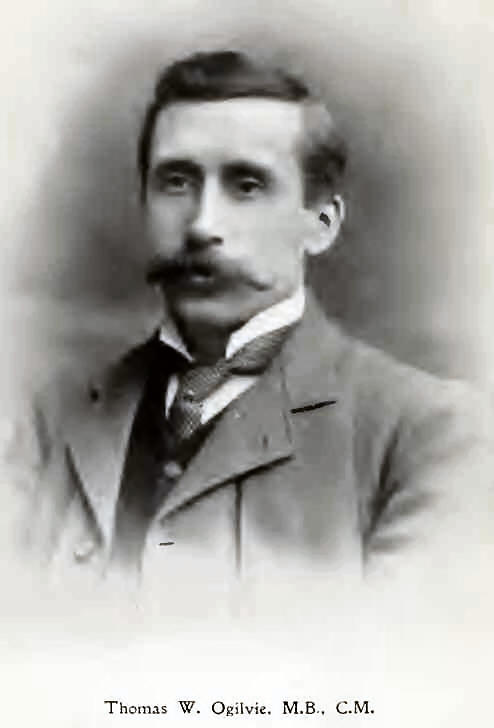
Here is an
Introduction to the Author from his book "Poems" (1911)
THOMAS WHITE OGILVIE
was born at Keith, Banffshire, on the 23rd January, 1861. His
parents were the late John Ogilvie, a highly respected merchant of
Keith, and his wife, Elizabeth White, daughter of John White,
farmer, Morayshire. There was a family of eight, of whom only two
now survive, the Rev. John Ogilvie, the Manse, Slains, and Mr.
Charles George Ogilvie of Delvine, Perthshire, and of Earlsmont,
Banffshire. Thomas was educated at the Public School, Keith, and
afterwards spent a few months in a law office there, but not being
enamoured of the law, he entered a local chemist’s shop. After a
brief sojourn there, he migrated to Aberdeen in 1876, and became an
apprentice to the well known firm of Davidson & Kay, chemists, where
he remained ten years, latterly as their principal assistant. He
then decided to graduate in medicine, and accordingly matriculated
at Aberdeen University.
His career at the
University was exceptionally brilliant, as may be seen from the
following record:—
First Bursar in
Medicine.
First Prizeman and Medallist in Zoology.
First Prizeman in Botany.
First Prizeman in Junior Anatomy.
First Prizeman in Senior Anatomy.
First Prizeman in Histology.
First Prizeman in Comparative Anatomy.
First Prizeman in Practical Chemistry.
He graduated M.B.,
C.M., with Honours, and during his undergraduateship, he occupied
the following important posts at his Alma Mater:—
University Extension
Lecturer in Biology.
Two years Demonstrator in Zoology, and
Prosector in Anatomy.
During his University
career he began the important work of the re-organization of the
Natural History Museum at Marischal College, and succeeded in
effecting many important improvements in this department, a work
which was much appreciated by the University authorities. As one of
the editorial committee of Alma Mater, he took his share in the
literary activities of that department of student life. In addition
to his University work, he successfully carried on evening classes
for teachers in such subjects as Botany and Natural History. His
abilities were undoubtedly of an exceptionally high order, and, as
will be obvious from the above, he was no ordinary student. He was,
in fact, what is sometimes called a many-sided man, and was
possessed of a personality the charm of which it is not easy to
over-estimate. Naturally his friends anticipated for him a brilliant
future. That these hopes were not fully realized must at once be
conceded, and this may be accounted for in a great measure by
indifferent health.
Long after our Author
had left the service of Messrs. Davidson & Kay, they wrote of him as
follows:—
“His business
capacity, scientific attainments and devotion to work and duty,
gained for him the confidence of employers and the respect and
esteem of everyone he came in contact with, and his brilliant
after-career at the University gave great pleasure to all his
friends.”
During the ten years’
service with that firm, he was an earnest worker in Natural History,
Botany, and kindred subjects, and many a happy hour did he spend
botanising on the Hill of Tullos, Scotston Moor, and such-like
places in the vicinity of the city. At the same time, he did not
neglect either his ordinary work or general literature. He was an
omnivorous reader, and was, in particular, passionately fond of
poetry and history. He did not confine himself to the great or
better known writers, but loved to search out gems of poesy from the
minor poets. It was indeed the enthusiasm he displayed in this
delightful department of literature that first drew our attention to
the value of the minor poets, a lesson which we have never
forgotten. We well remember one evening, in the upper room of
Davidson & Kay’s, reading with him the chapter in that deeply
interesting volume of Hill Burton’s “The Book-Hunter,” titled “Some
Book Club Men.” When we came to the description of some of the fine
songs of Sir Alexander
Boswell, such as,
“Jenny’s Bawbee," “Guid Nicht and joy be we ye a’,” and “Jenny dang
the Weaver,” the expression of delight that flashed across his
intellectual face, and the intense interest with which he followed
the extracts from “Skeldon Haughs, or the Sow is flitted,” remain to
this day imprinted on our memory. The next night we met, he had
obtained a copy of and was quite familiar with Boswell’s poems. The
above anecdote may appear trifling, but it is illustrative of the
enthusiasm and energy which he threw into all he did, and of his
usual occupations in his spare time. He was either deeply engrossed
with “Darwin” or “Huxley”; working with a microscope; classifying
botanical specimens; or, with a congenial friend, studying some of
the masterpieces of literature.
Ogilvie’s subsequent
professional career may be briefly told. Immediately after
graduation, he accepted an appointment as Medical Officer to the
Rubies and Sapphires of Siam, Ltd., and, while in Siam, his devotion
to duty and to the interests of his employers, at a time of great
trial, earned for him the highest commendations; but the strain was
too much for his not over-robust frame. He was prostrated with
malarial fever, and had to be carried through the jungle to Bangkok.
At one time he was dropped in the jungle by the native bearers and
left to his fate, but he was, fortunately, near a Buddhist temple,
to which he was able to crawl, and a priest there, gave him the
succour he needed. Soon afterwards, the bearers, somewhat afraid for
the consequences of their cruel desertion, returned, and taking
leave of his kind friend the Buddhist priest, he arrived at Bangkok
more dead than alive. He returned to this country in shattered
health, and although he exhibited all his old intellectual alertness
and enthusiasm, his health was never so good after that unfortunate
experience. When it is added, that he lost the most of his personal
and medical belongings during that terrible journey through the
jungle, and that the Company was unable— in consequence, mainly, of
the occupation by the French of the territory within its sphere of
influence—to implement its obligations to him, it can readily be
understood that he was injured not only in health but in pocket.
A two years’ spell of
fairly easy work at Longhope, Orkney, somewhat restored his health,
and on the suggestion of a friend, Dr. Ogilvie came to Aberdeen in
1895, and commenced practice in Torry, then a small but rapidly
rising suburb.
Little need be said
of the seven years during which he practised in Torry, as the events
in the life of an ordinary medical practitioner, in a working-class
locality, do not usually present features for stirring narrative. He
threw himself into his work with characteristic energy, and in that
brief period, by dint of sheer hard work, he not only built up a
large and lucrative practice and made himself prominent in the
public life of the locality, but also established a reputation as a
writer of elegant verse, as a versatile lecturer, and as a raconteur
of no mean order. It was during this time that the most and the best
of his poems were written, and they appeared in Brown's Book-Stall,
Bon-Accord, and the evening press of the city. Though those engaged
in public life invariably make enemies as well as friends, Dr.
Ogilvie had the art, and that in no ordinary degree, of making
friends, and we believe that his enemies, if any, were few and far
between. When, therefore, in 1902, he decided, mainly on account of
his health, to leave this country for South Africa, the efforts that
were made by the people of Torry to retain his services, and the
expressions of regret that his departure evoked, were too widespread
and spontaneous amongst all classes of the community, to be other
than sincere. His public work had already been formally recognized
by his being made a Justice of the Peace for the County of the City
of Aberdeen. A brief sojourn in Kimberley; three years in practice
at Gringley-on-the-Hill, near Doncaster; an attempt to establish a
new home in British Columbia, which failed in consequence of another
collapse in health; then about a year of hard work as a locum in
London, bring us near the end. In 1908 he purchased a practice at
Willesden, North London. On the 17th October he took possession of
the practice and house, and on the following morning he was found
dead. The ill health from which he had suffered more or less for
years, had, notwithstanding his indomitable courage, told on his
somewhat enfeebled body, and hastened the end. So at the early age
of forty-eight, and when just about to enter on what promised to be
a congenial sphere of usefulness, died one of the staunchest of
friends and most kindly and loveable of men, leaving behind him a
widow with five young sons, and also a memory that will long be
cherished by all who had the good fortune to own his friendship.
As yet, little has
been said of our Author as a writer of verse. That he was a keen
lover of nature goes without saying. One has but to read some of the
pieces written when still a youth, to appreciate at once that from
boyhood, nature had claimed him for her own. In fact, nature in her
varying moods was the dominating note of his life, and is the
dominating note of the best of his poems, and these will doubtless
have a charm for most readers: but the strong sense of humour which
permeates some, and which made him so ideal a companion, will
undoubtedly appeal to others. That he was a charming lecturer many
audiences knew well, but that he had the gift of poesy was known to
only a small number even of his friends. This is accounted for by
the fact that he usually wrote over the initials “T. W. O.,” varied
occasionally by “O. W. T.”; latterly adopting the French numeral
“Deux”—a play upon his initials—as a noom-de-plume, and by that he
was known as a writer. We do not feel justified, even if qualified,
to enter on either an appreciative, an analytical, or a critical
survey of his poetry, but we venture to say that one who was
capable, at the age of sixteen, of writing “Art and Nature,” “Autumn
in the Duthie Park,” and “Tullos Hill,” and again to produce
“Anxious,” “Saint Fittick’s,” and “Waiting for the Nightingale”—in
all of which there is expressed, so exquisitely, such a variety of
feeling—could, given the opportunity and the leisure, have written
much more of a quality of which any writer might well be proud. The
charming ode “ The Bards of Bon-Accord ” (with the capital portraits
of William Carnie and William Cadenhead by Mr. William Smith, Jun.),
was, like the ode to Cadenhead himself, written on the impulse of
the moment, and we have the best of reasons for knowing how much
both bards appreciated the compliment paid them by their young
compeer.
We should not omit to
mention the “Book of Saint Fittick,” a history of Torry, written and
presented as a Bazaar Book to Saint Fittick’s Church, Torry, in
December, 1901. This book was profusely illustrated with drawings by
the following local artists:—Messrs. George Davidson (now deceased),
J. A. H. Hector, Stephen Reid, and William Smith, Jun. An excellent
sketch of the proposed Well of Saint Fittick was also contributed by
Mr. William Kelly, architect, and pity ’tis that the well, as
designed, was not erected. This was his last public service to the
district, and in that delightful volume he has made live again, with
all their quaint and curious customs, the fisher folk of the
long-forgotten past. We do not profess that it possesses absolute
historical accuracy. It could hardly do so, written as it was at
high pressure and in the midst of so busy a life, but we do claim
for it literary ability and taste, in both prose and verse. One has
but to read the verses at the beginning of each chapter, in
imitation of Sir Walter Scott’s quotations from old authors, to see
that Ogilvie had in him the gift of true poetry. Although we have
only referred to poetry, it should in justice be added, that Dr.
Ogilvie made occasional contributions of short stories to the press,
and these were in no way inferior to his poems.
A well-known local
journalist (U.U. S.), writing of our Author after his death, said:
“While in Aberdeen Dr. Ogilvie was a frequent and valued
contributor, both in prose and verse, to the local press. His
writings— one and all—displayed great literary grace and poetic
fervour and imagination, and withal, he had a rare gift of
spontaneous humour. For several years nearly every monthly issue of
Brozun’s Book-Stall contained something from his pen, over the
signature of ‘Deux.’ He was a ripe scholar in the true sense of that
term, and his books to him were full of living friends with whom he
could not only pass the time, but so to say, ‘pass the time o’ day ’
as with an everyday acquaintance, as exemplified in his dream-poem,
‘Storylanders.’ Dr. Ogilvie’s most complete work was ‘The Book of
Saint Fittick.’ It was a gathering together, as the Author puts it,
of some fragments of history relating to the Torry district, and
what is inseparable from it, the harbour and river-mouth. To this
work the doctor’s many young artistic friends lent a willing helping
hand, and the volume is enriched with between thirty and forty
pictures and plates of the district. It is an ideal work in every
respect, and its success was immediate and phenomenal, and
fortunate, indeed, is the collector who possesses a copy. A kindlier
soul, or one more richly endowed with the graces that make
friendship valued and enduring, never ‘passed out from the crowd.’”
The task of
collecting, and the process of selecting the poems suitable for
publication from amongst many that were of a semi-private nature,
have been to us a pleasure, although in many respects a somewhat sad
one. Memories of the past seem to jostle each other as one reads the
lines, and although it may well be that in our affection for Thomas
White Ogilvie we may be accused of over-rating the literary value of
his writings, yet we presume to believe that many of his poems will
rank as among the best that have been given to Aberdeen by her
honoured list of minor poets; that they will stand both comparison
and the test of time; and that readers will heartily endorse our
opinion, that in presenting this volume to the public, we are only
doing justice to the talents of one who was a distinguished graduate
of our University, and who, although a Banffshire “loon” by birth,
is, we believe, well worthy of a place amongst the Bards of
Bon-Accord.
D. S.
Aberdeen, October, 1911.
Here is a sample
Poem...
A Ballad
THE GOLFER AND THE BRICKLAYER
by Thomas White Ogilvie M.B., C.M. (1861-1908) of Aberdeen, Scotland
[This ballad first appeared in Brown's Book-Stall, Aberdeen, in
April, 1899.]
Jim Jolly was sound in both body and mind,
But his friends have their doubts if he still is;
Some subtle infection, 'tis perfectly plain.
Has scattered the germs in his blood or his brain
Of the Golfi-gum-gutty Bacillus.
Jim J. is a townsman of credit and weight,
Quite a model of sensible bearing,
But now when he's mentioned there's noddings and winks
Since this direful zymotic he caught on the Links,
And is bent on the red jacket wearing.
One Saturday morning, quite innocentlie,
Jim went down to see what the game was,
He saw a white ball on the tip of a "tee,"
Then a swing and a swish and afar o'er the lea
Like the flight of a swallow the same was.
Away over bent and away over sand,
Over hazard and whinbush and bunker,
Jim followed that ball over acres of land
As it skimmed, skipped, or soared from a lofting shot grand.
And he reckoned the game was a clinker.
Then Encyclopedias of sport having got.
And a " Badminton " sought for to borrow.
He longed for the morning to practise the shot,
Resolving at daybreak to be on the spot—
But it rained cats and dogs on the morrow.
Of expense quite regardless he gathered the tools
In a slender bag brand-new and brown.
And the weather still raining he read up each rule.
Too proud he to go with a caddy to school.
And he spoke golf all over the town.
He learnedly talked of his mashie and cleek,
He knew all the points of a putter,
Where the niblick was strong, where the driver was weak.
And the best build and brand of a brassie to seek,
And all technical terms he could utter.
But day after day the barometer fell.
And the weather got wetter and wetter.
Till Jim wished the clerk of the weather in ----well ;
He was dying to golf, could you honestly tell
That your words had been wiser or better?
But Jim J. must die of this fever or "swing,"
So he cleared out the chairs and the table,
And into the parlour his driver did bring.
And he tethered a ball to a bundle and string,
And hit it as hard as he's able.
When that curious game on the carpet was done,
Of the holes made he rarely has spoken ;
His first in the mirror he got with a "one,"
Then two in the window he had with a run.
And a bust with this record was broken.
Mistress Jolly thought golf such a beautiful game,
No sport she was sure could be finer;
But withering sarcastic she spoke all the same,
When she said that if often to such " tees " he came,
He would make some good holes in her china.
Next morning at daybreak Jim went to the green
At the back, where his wife dries and bleaches,
With the ball and the bundle all smiling serene,
The rummiest golfer that ever was seen,
In a smoking-cap, braces, and breeches.
Just over the way on a neighbouring feu
A tenement mansion was rising.
And up and down ladders there went one or two
Of the workmen with bricks on their heads, quite a few.
All balanced with skill most surprising.
Jim studied his grip and he practised the swing,
Oft foosled the ball, sometimes hit it,
When the gutty would fly to the end of its string,
And Jim with the air of a golfer would sing
As he strode up the green to get it.
Replaced on the tip of a conical tee,
Jim touched his left ear with the whipping.
Then swinging his driver right vigorouslie,
Got the ball by a fluke just as clean as could be,
Broke the string, and away it went skipping.
Like a ball from the mouth of a musket it sped,
As it passed on its path parabolic.
But a blind hazard came in the shape of a head
With bricks on the top, and with hair just as red.
And a tongue with a speech diabolic.
Like a hundred of bricks that dozen came down.
Some language was mixed with the clatter,
And that bricklayer's face wore a terrible frown.
As he clenched up a ponderous fist hard and brown,
While blandly Jim asked "What's the matter?"
There were compliments passed which I will not repeat,
In that conference over the wall,
But a modus vivendi was found in a treat
For the mason consisting of whisky and meat.
And for Jim—he recovered his ball.
You can download a
copy of his book "Poems"
in pdf format here

PREFACE
SAINT FITTICK, the
ruins of whose church stand by the mouth of the "Cheerful Vale of
Tullos," was the Patron Saint of Torry. The "Book of St. Fittick" is a
gathering together of some fragments of history relating to the Torry
district and what is inseparable from it—the harbour and the river
mouth.
The writer of this
sketch makes no claim to be a historian of the district, or to have
made any original research on the subject; but as a lover of this
river mouth, and craggy shore, and hill-girt hollow, he has strung
together such items of local interest as he may have gleaned in
reading our local literature or picked up in converstation with old
inhabitants.
Such a subject bristles
with controversial points—these are not discussed here; the writer has
tried to make only such statements as are supported by respectable
authorities.
The name of the Patron
Saint illustrates the difficulties the historian of Torry has to
encounter. S. Mofutacus, S. Monfutacus, Sanct Mofette, Sanct Musset,
Sant Mufott, S. Futtack, San Fittick, St. Fiacre, S. Fotinus, S.
Fithack, S. Fittick, and—Blessed Thistle!—Sandy Fittick, are some of
the numerous aliases of this much mis-spelt Saint. What interest the
narrative lacks, it is hoped the illustrations will supply.
T.W.O.
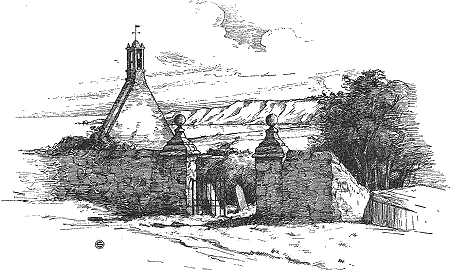
OLD KIRK OF ST.
FITTICK
THE KIRK
Out from the city's boom
and flare,
Dim-eyed and dazed the soul in me,
I wearied seek for thought and prayer
The lonely church beside the sea.
 |
N a quiet hollow, brown
and green and golden as the seasons of verdure pass, within the reach
of the sea-foam, blown landwards when a south-easter fills the bay
with crescents of surging white, stands the old church of St. Fittick;
roofless are the walls within which the voice of living man has long
ceased to plead and to urge, but within and without are gathered the
worshippers of old; the clamour of the bell, still musically sonorous
from its quaint belfry, rouses them no longer, their last sin is
committed, the final word of grace is spoken, and in the silence they
wait till the dawn of a last day breaks on yonder bay that frets and
murmurs at the hollow's mouth, as it murmured in their ears in the
quiet Sabbaths of yore, when their psalms mingled with the eternal
chant of the sea—of that sea which itself is a graveyard to their
people, for the lives of the dwellers by the shore, whose work is on
the waters, are wrapped in an atmosphere of tragedy; their traditions
are of wrecks, and the events of their lives are dated from disasters.
Six and a half
centuries have come and gone since, with all the imposing ceremonial
of the Church of Rome, Bishop David de Bernham dedicated this little
church, and part of the walls now standing are believed to have been
raised by the masons of those early thirteenth century days ere Bruce
had arisen to fight for the crown, and Wallace for the independence of
their country. For over three hundred years the priests of the Church
of Rome ministered within its walls. Then came the Reformation, when,
what came to be considered the superstitious rites and blasphemous
claims of the priests were swept away, and another worship guided the
lives of the people who gathered to their devotions in the Tullos
valley. For a century and a half after the Reformation, Bishops and
their kindred ruled over the Church of St. Fittick, until early in the
eighteenth century Richard Maitland, the last Episcopal minister of
Nigg, whose initials are seen to this day cut on the sandstone of the
belfry, was deposed for praying for James, called the Pretender, in
those wild days when the standard of rebellion was raised on the Braes
of Mar, in the fruitless struggle that ended at Culloden. Since that
day in July, 1716, Presbyterian clergy ministered in the old church to
the spiritual needs of the people of Nigg, until 1829, when St.
Fittick was abandoned to the dead and the people gathered under that
picturesque tower, seen, from the old churchyard, standing out against
the western sky from among the dark firs of Tullos and Kincorth. Well
has it served and serves, but the river is spanned and the city grows
on its southern bank, and a new St. Fittick's arise to share in the
guidance Godwards.
' Tis a sweet little
old ruin this old church with its simple but finely proportioned
lines, its sharp east gable surmounted by the quaint belfry in which
hangs a bell still rung at funerals "Sabata pango, Funra plango,"—"Sabbaths
I proclaim, at Funerals I toll,"—says the legend on the bell. This
bell was made by John Mowatt, and Old Aberdeen blacksmith, who had
learnt the craft and mystery of bell-founding from the French
bell-maker, Gelly, who, half a century before, sojourned several years
in the Old Town, casting and re-casting many of the city bells. It is
now over 140 years since it was hung in the little steeple, and many a
curious crowd of red-cloaked and snowy-mutched woman it has drawn in
the old days from the villages on the cliffs, from Downies and
Burnbanks and Cove.
Time has obliterated
many an old inscription and relic from church and graveyard, which
might have recalled the habits and interests of the old dwellers by
the mouth of Dee and Tullos hill and hollow, but there yet remain some
vestiges on the walls which are eloquent of beliefs that have faded
and of customs that are extinct. By the open doorway, in the south
wall, hang a few rusted links of chain, all that remains of the
ancient jougs in which the scolds, the story-tellers and other minor
offenders were fastened up at the church door to do penance in sight
of the congregation, as it passed into worship. The ecclesiastical
tribunals of the days when the jougs held their culprit, inflicted
many a punishment which, if wholesome and necessary then, have long
since been condemned and fallen into disuse. "Expose in sackcloth on
the high and low stools of repentence in the church, imprisonment in
the steeple and the noisome dungeon under the vestry, flogging at a
stake after conviction and sometimes before it, ducking in the river,
pillorying in the public streets, carting through the town with a
crown of paper," and many another curious infliction not likely to be
revived, although the offences still linger with us.
There were lepers in
the Tullos Valley in the days when the priests swung the censers in
the church of St. Fittick. Outcast and miserable, they might not
mingle with the people as they worshipped, but in the church wall,
within sight and hearing of the priest, there was a little oblong
opening, through which, himself unseen, the leper could join in the
service. On the north wall, near the ground, we can to-day see this
"Leper's Window," and over against it on the south wall the doorway,
now built up, by which the priest approached the altar. Rich and poor
suffered from this loathsome disease, and in Aberdeen there was a
"Lepers' House" in the vicinity of our present Nelson Street, and
certain curious provisions were made for their maintainance, such as
that every load of peats that came to town had to yield up one peat to
the lepers.
The old Baptismal Font
of the church is now preserved in Marischal College. Could some old
priest who blessed and banned in the days when holy water filled this
great rude bowl, but know its history since his reverent congregation
crossed themselves before it, how might he cry with Hamlet
"To what base uses we may return."
For, until rescued from its degradation by its
present custodian, it served for many years as the trough in a poultry
yard.
From among the many clergy who have ministered in
old St. Fittick's Church there is one character who stands out
prominently in the traditions of the parish. This is James Farquhar,
the first Presbyterian minister in Nigg. He was a man of unusual
physical strength, and on account of this qualification he was
frequently employed to preach churches vacant on the deposition of the
Episcopalian when that duty was accompanied by no little personal
danger, for many a congregation resisted the separation from their old
pastors.
On one occassion on going to preach vacant the
parish of Lochlea in Forfarshire, Mr. Farquhar learned that there was
a very vigorous opposition to the proposed change, and it was likely
that a serious attempt would be made to prevent him carrying out the
instructions of the Presbytery. Dressed as a farmer, wearing a big
round bonnet and carrying a substantial stick, he approached the
church and mingled with the crowd, discussing with the intimate
knowledge of his apparent class the crops and the weather. The
appointed hour passed and the crowd became impatient. At last Farquhar
said, "There's little sign o' ony minister comin', would you hae ony
objections tae my gi'ein you a word." "O, nane ava," came the ready
response. Up rose James, and, mounting the pulpit, preached the church
vacant before the dumbfounded congregation.
On the occasion when he entered on his duty at St.
Fittick's he found two Episcopalian partisans pummelling the bellman,
who had ventured to ring in the first Presbyterian service. Laying his
powerful hands on the aggressors, he knocked their heads together and
stood by till the bellman finished, and then led the way to the
church.
His tongue seems to have been as direct and as
vigorous as his fist. Once a "dandy" dressed in a red-coloured vest,
embroidered with lace, made some disturbance in St. Fittick's during
the prayer. "O Lord, if it be thy holy will, hew down that scarlet-breistit
sinner wi' the gryte gully o' they gospel," thundered his reverence,
and then concluded his prayer in peace. Such a markedly popular and
plain-spoken personality would have enemies, of course. He was called
John Gilon, for nickname, and there still lingers two lines of some
forgotten lampoon
"John Gilone, the great horse leech,
When he came first to Nigg to preach."
In the "Rabblers Rabbled" of William Meston, the
poet, sometime Professor of Philosophy at Marischal College, we find a
reference to the feats of Mr. Farquhar in connection with another
Presbyterian worthy
....in Whig Kirk planting,
Where people's inclination's wanting,
And there he mighty feats had done
In company with John Gilon.
Such memorials of the dead as may have existed
before the Reformation have long since crumbled into dust, but in the
churchyard, near the S.E. corner of the church, there is a flat stone
with an inscription which vividly recalls the turbulent days of civil
war, when that military genius, "Montrose", leading the troops of the
King against the Covenanters of Aberdeen, defeated them, and let loose
his Irish mercenaries on the town, who sacked it, running mad in the
streets, plundering and slaying without distinction and without mercy.
Spalding, the local chronicler of the troublous times of the Covenant,
tells a vivid story of the fight which began at the "Twa Mile Cross."
"There was little slaughter in the fight, but
horrible was the slaughter in the fight fleeing back to town, which
was our townsmen's destruction; whereas, if they had fled and not come
near the town, they might have been in better security, but being
commanded by Patrick Lesly, provost, to take to the town, they were
undone. Yet himself and the prime Covenanters being on horseback, ran
away safely: The lieutenant follows the chase into Aberdeen, his men
hewing and cutting all manner of men they could overtake within the
town, upon the streets, or in their houses, or round about the town as
our men were flying, with broad swords, without mercy or remead. Thir
cruel Irishes, seeing a man well clad, would first tirr him, to save
his clothes unspoiled, syne kill the man.... Montrose returned to the
camp this samen Friday at night leaving the Irishes killing, robbing,
and plundering this town at their pleasure, and nothing was heard but
pitiful howling, crying, and weeping, and mourning through all the
streets."
|
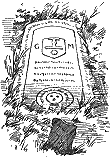
WILLIAM MILNE'S
TOMBSTONE |
Under the flat stone at the S.E. corner of St.
Fittick's Churchyard lies one of the victims of "thir Irishes," the
inscription, which is in Latin, is thus rendered in "Jervise's
Epitaph's" : "William Milne tenant of Kincorth, slain by his enemies
on 10th July, 1645, for the cause of Christ, here rests in peace from
his labours, whom piety, probity, and God's Holy Covenant made happy,
fell by the sword of a savage Irishman—I am turned to ashes."
|
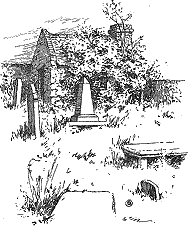
THE WATCHER'S HOUSE |
In the N.E. corner of the kirkyard stands the
"Watcher's House," erected in the days when the seekers after medical
knowledge were struggling for the good of humanity against the
obstacles raised by its own prejudices and distrust, and when this
lonely chuchyard was often pillaged of its newly buried dead by the
body-snatchers or "resurrectionists" to supply Marischal College with
material for dissection. When the Dee was diverted into its present
channel in 1874, on trenching the garden ground beside "Jessie
Petrie's Inn"—the foundations and part of the garden wall of which are
still standing at the foot of Ferry Road—two skeletons were found, and
tradition in the village tells how the body-snatchers, caught at their
gruesome toil, were pursued to the river, and being unable to cross
without detection, hid the bodies behind the inn, and were never able
to recover them again. Better days are with us, and now no
sacrilegious hand disturbs the bones that moulder in this "Auld
Kirkyard," where it is believed that not even a worm, man's last bosom
friend, may enter. A local tradition tells how a portion of the sacred
soil was carried from Ireland after St. Patrick had banished the worms
and snakes. Since when no worm has ever been found in the holy
precincts of St. Fittick.
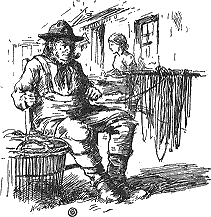
THE WELL
And find where sea winds
lift the foam,
And stir the larch on Tullos hill,
As in the saintly days of Rome,
The Holy Well has healing still.
|

THE JOUGS. |
y the brink of the bay, not far from the old
church, there is another monument crusted with old associations and
traditions. In advancing from one form of religious belief to another,
there is a tendency among men to mingle with the higher and purer
worship they have attained some trace of the superstitions they have
abandoned. The golden calf is raised by the Israelites while their
leader is in the presence of Jehovah, and pagan rites creep into the
observances of the early Christians.
St. Fittick's spring still drips its mite of water
into the great sea, and it dripped and dribbled when the Old Aberdeen
blacksmith hung his bell in the belfry yonder. It still soaks through
the turf among the eyebright and sea-daisies as when, over 600 years
ago, it quenched the thirst of the masons labouring at the foundations
of the church, and it flows to-day as cool and clear, if not so
voluminous, as when the warriors of old were piling cairns on the
Tullos Hill over the bodies of their dead chiefs, ere the name of
Christ had penetrated the Grampian hills, or men dreamt of raising
temples to his name in the Tullos hollow. But the broad lawn of green
sward, which streched between the well and the bay, has been, in
recent years swept away by the encroachment of the sea.
Far back in the dark days of pagan worship each
spring by woodland and sea-shore had its peculiar spirit, believed to
have some control over human destinies and to be propitiated by rites
and sacrifices, and so ceremonies were performed by the wells and
offerings were left on their banks. When Christianity penetrated among
a rude people—prone to superstition—the saint supplanted the pagan
diety, but often the pagan rite was continued and the intercession of
the saint sought by the old offerings.
|
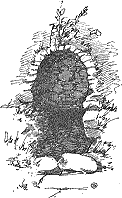
THE LADY WELL. |
St. Fittick's Well was in great repute in the days
before the Reformation frowned on such superstitious observances, and
long afterwards in spite in ordinance and infliction by the powers
spiritual and temporal. Down, even till within the memory of people
still living, the Well was frequented on account of its healing
powers, and people gathered from country and town to lay down their
simple offerings—a rag, a nail, a pin—and to seek some benefit. By
degrees the religious significance of the rite was lost, but the
custom of visiting the well continued, and on the first Sunday of May
great numbers of people, chiefly from the city, visited the spring and
the neighbourhood, and gave themselves up to amusement and revel on
beach and sea brae. Town Council and Kirk Session struggled by laws
and punishments to stop those Sunday wanderings and to efface those
vestiges of old superstitions, but the customs of centuries die hard,
and to-day young and old, to whom the name St. Fittick is a
meaningless term and the repute of his well quite unknown, ramble on
Sunday's and week-days to the bay once called by his name, and they
find the old power still lingers, for the beauty of the Bay, the fresh
sea-breeze, and the pure draught from the old spring still bless and
heal.
On the wayside bank to the east of the old church
there is another well, known of old as the Lady Well,
"Cooled a long time in the deep
delved earth"
roofed with an old Saxon vault, and reached by a
short flight of time-worn stone steps. It is a quaint and interesting
spring, but tradition has brought down little knowledge concerning it.
A little way south from St. Fittick's Well, or the Downies Well, as it
is also called, stands the great detached mass of cliff called " The
Downies Craig,' united to the mainland by a narrow neck, " The Brig o'
ae Hair," and shewing a curious perforation in the neighbouring cliff,
well named " The Needle E'e.' The Downies Craig is closely linked in
history with St. Fittick's Well. The Craig was the usual limit of the
wanderings of the May Day revellers. Here they crossed the "Brig o' ae
Hair," very different in those days from its present state, for the
slenderness of the connecting neck, which gave it its graphic name has
been in great part massed by the rubbish, tilted over it, when the
adjacent railway cutting was made. On the summit of the Craig there is
a stretch of fine green sward, and thereon, the brig crossed, the
youthful revellers used to cut the names of their loves.
The Craig, to the North and South of the narrow
"Brig," descends sheer to the water, a mighty pendicular wall of
gnarled and twisted gneiss. It forms with the landward cliffs a
profound chasm, and and narrow, into which in storm, the wtaer is
driven with terrific force and deafening turmoil. Eatswards to the sea
the Craig descends gradually, with mighty boulders, grey-green with
sea lichen and hacked and fissured by the tempests of many thousand
winters. Here is the haunt of the hooded crow, wariest of birds, which
perches on the inaccessible pinnacles and rears its brood in the
spray-dank hollows. There are many caves in the cliffs here, sought in
olden times by far other wanderers than May Day revellers. In the year
1640, the ranks of the army of the Covenant were filled by many a
forced recruit from the streets of Aberdeen. In this year we read that
"seven score burgesses, craftsmen and their servants were seized and
forcibly sent off to join Leslie's army for the invasion of England,
and many others, to escape the same fate, fled the city and sought
shelter about the craig of Downies and the recesses of the
neighbouring rocks."
The Old Burgh and Session Records of Aberdeen again
and again shew the paternal anxiety of minister and magistrate to
check the pilgrimages to the south side of the Dee, for, once the
religious meaning of the journey had passed away from the minds of the
people. it tended to degenerate into an opportunity for revel and
excess, and the solemn reflective quiet of the Sabbath, which the
God-fearing Fathers of the City anxiously sought to foster, was
seriously disturbed by the liberties claimed by the devotees of St.
Fittick.
The fishermen of Footdee did not object to this
popular crossing of the water; it was a lucrative custom for them, but
they were often fined and censured for hiring their boats on Sunday
and watching men were also stationed at the ferry boat to note such
persons as crossed the water to Torry, and order them before the
Session for reprimand and fine. A few extracts from the old records
will illustrate this state of matters three hundred years ago.
On the 8th May, 1603, "The said day it is thocht
expedient that ane baillie with twa of the Sessioun pass thro' the
toun everie Sabbath day, and nott sic as they find absent frae the
sermones, ather afoir or efternone, and for that effect that they pas
and serche sic houses as they think maist meit, and pass athort the
streits, and chiefly that now, during the symmer seasoun, they attend,
or cause ane attend at the ferrie boat and nott the names of sic as
gang to Downie that they may be punishit conforme to the act set doun
against the brackairs of the Sabbath."
On 1st June, 1606, four men are fined "Ilk ane o'
them in forty pence, to be payed to the puir for thair passing over
the water to Downie on Sunday last the tyme of the efternones sermon."
In 1616 there is the following municipal enactment.
"Gif ony man, womane, barne, or servand, sal be aprehendit in ony time
comin', going in the nicht, either be land or sie, to Downie, Sanct
Fittatk's Wall, or uther wyis vaiging idillie to ony superstitious
place, the persone being maister or mistress of a familie, their sones
and dochteris, sall pay furtie schillings of onlaw, totes quoties; and
the servants twenty schillings; and the maisters to be comptabill and
anserable for their wyffis, bairnies, and servandis."
Again, on the 28th Nov., 1630. "The said Margaret
Davidson, spous to Andrew Adam, was adjudjet in ane unlaw of fyve
pounds to be payed to the Collection, for directing her nurish with
her bairne thairin for recoverie of her health, and the said Margaret
and her nurish were ordaint to acknowledge thair offence befoir the
Sessione for thair fault and for laving ane offering in the well.
"The samen day it was ordaint be the haill Session
in ane voce that whatsomever inhabitant within this burgh wis found
going to Sant Fiacker's Well in ane superstitious manner for seeking
health to thameselffs or bairnes shall be censured in penaltie and
repentance."
"The belief in the Well gradually waned, but there
are still people living who remember some instances of the old rite.
One old woman in Torry, approaching her century of life, to whom the
writer of this sketch appealed for some reminiscence of her early
days, brightened up at the mention of St. Fittick's Well, the dull
eyes gleamed for a little, as a flash of recognition lit up the worn
old face. "I mind fine it was Jessie ____'s bairn, a thrivin' lassikie
till it got amo' its teeth, an' sine it dwined and dwined and naething
did it ony guid. I dinna ken fa' put it in Jessie's heid, but ae
meenlicht nicht she cut twa sheaves o' breid and put them in her
breist, and took the bairnie and gaed awa' tae the wallie at the Bay
o' Nigg, and she weish the bairnie in the wall, and syne she laid doon
the breid tae the fairies and cam' awa hame, and fae that day the
bairinie threeve and there are bairns o' that bairn in Torry the day."
Once started, this old lady gave many a glimpse of the customs and
superstitions of the Torry of a hundred years ago. "We hid ither wyes
o' curin' bairns and fouk fin I wis a lassie. I mysel' was the last
wife in Torry to cure a bairn wi' unspoken water. There wis a burnie
ca'ed the Struak ran doon oot o' far the Brickworks cam to be, past
Jessie Petrie's public-house by the waterside. The bairnie was wastin'
awa' till a shadow, an' it couldna eat an' it wouldna sleep, but just
murnt and murnt, an' its mither was sure the fairies had got at it. So
ae nicht I took a sma' pailie an' put a shillin' in't, and gaed awa'
to the stroopy at the top o' the Struak an' let the water fae the
stroopy run on the shillin', and if it turned heads up the trouble was
in the bairn's head, but if it turned tails up it was in its system,
but comin' or gaun I spak' tae naebody—for that's waht mak's unspoken
water. I met twa or three lassies I kent an' they cried to me, but I
said naething, and I met a lad I kent richt well, but I didna speak
tae him; and I got hame and weish the bairn wi' the unspoken water and
it got better. Did ye iver hear o' three times roon the crook?" she
continued. "I min' on the wives i' my mither's hoose daein' that, when
I was a bairn. They took three roon stanes fae the Bay o' Nigg, an
they ca'ed ane the heid, anither they ca'ed the heart, and the ither
ane wis the body, and they put them in the red fire, and the first
stane that crackit was the pairt the trouble was in, and then the
unweel body was carried three times roon the crook o' the big lum wi'
the unwell pairt held next to the crook, an sometimes they got better
an' sometimes they didna, jist the same as wi' the doctors noo-a-days."
THE BAY
And men may joy and men
may moan,
And generations come and go;
Eternal croons the undertone
Of tireless tides that ebb and flow.
This bay has borne other names than that familiar
to us. Saint Fiacre is the old name of the patron saint of this
district. Tradition says he was the son of Eugenius IV., an old Scotch
king of doubtful existence. The saint, leaving his native country,
retired to a hermitage on the Continent, where he died in 648, and was
buried in the Cathedral of Meaux, in France. The Bay is called after
him in many ways. St. Fittick's Bay, the common modern form of his
name, is derived from Ma Fithatk, the Celtic form of St. Fiacre; by
corruption the name Sanct Moffat's Bay is sometimes met with; while in
one old chart in the possession of Mr. Barnett, the delineator makes a
thoroughbred Scotchman of the old Saint, and calls it Sandy Fittick's
Bay.
It is a pretty place, this sheltered bight in the
rugged coast line, with its fine bend of foam-frilled water and its
beach of great smooth pebbles clattering incessantly in the ebb and
flow, pent in to the north by the bold peninsula of the Girdleness
with its lighthouse, and to the south by the low broken headland of
Greg's Ness. Interesting at all times is this little bay—in calm, when
the waters heave smoothly like a bosom in sleep,
And for hours upon hours,
As a thrall she remains,
Spellbound as with flowers,
And content in their chains,
And her loud steeds fret not, and lift not a lock of their deep
white manes.
- in storm, when the breakers surge shorewards
great curving masses of dazzling white, and roar on the pebbles
At the watchword's change,
When the wind's notes shift,
And the skies grow strange,
And the white squalls drift
Up sharp from the sea-line, vexing the sea till the low clouds lift;
but most beautiful when the moon hangs low over the
sea, and a gleaming path opens out from the Bay, across the open water
beyond, and ships pass from dark to dark across the shimmering way,
and on the shore the old church is transfigured in the soft light,
while tinkling musically the castanets of the water-stirred pebbles
rattle by the verge,
On the south side of the Bay, by the old Well, the
shore is a precipitous bank rapidly crumbling away. The path along the
top of this bank is yearly retreating inland, and the old paths which
but a few years ago were safe, now end abruptly at the cliff's brink.
The old Well of the Saint, alas! is on this brink
of destruction, and another winter of fierce south-easters may
overwhelm it. About two years ago the spring was traced back a few
yards from the brink, and a temporary well, with the spring only
partially tapped, built at a safe distance from the sea, but we hope
the day is not far distant when a monument, worthy of its hoary
traditions and its fine situation, will present the cooling stream of
the old spring to the pilgrims who to-day are seeking health and
repose by the Bay of Nigg, for St. Fittick's shore is still a
favourite haunt of the townspeople, and on summer afternoons the
cheery kettle bubbles on a dozen rude hearths raised on the
sea-sward—innocent altars to the Goddess Hygeia.
There is a tradition that a stronghold called "
Wallace Castle " once stood on the north side of the Bay. There is now
no trace of it, and it is likely that this name was applied to the
ruins of one of the watch-houses which stood here. Immense quantities
of stone setts for paving the London streets used to be shipped at the
Bay of Nigg. These were prepared at the quarries in the parish, which,
when opened about 1770, used to give employment to 600 or 700 men. The
rounded oblong pebbles of this shore were also largely used as
cobble-stones, and were shipped in large quantities from the Bay.
|
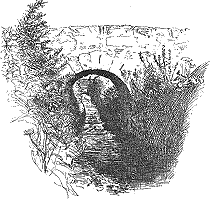
BRIDGE OF NIGG. |
There were in the old days other industries by the
Bay that brought a livelihood to the people in the neighbourhood.
There may still be seen on the north side, beside the hatcheries, the
foundation of the buildings of the old salt pans, where salt was made
from the sea water, and there are living in Torry to-day old people
who worked there. Here, also, the manufacture of kelp was a lucrative
trade. The tangle and seaware were gathered at low tide, and, after
being dried in the sun, were burned in heaps on the shore. The ashes
were the kelp, very valuable for the alkalies it yielded. Dr. Cruden,
who ministered over a hundred years ago in the old St. Fittick's
Church, informs us that in one year, 33 women and an overseer were
employed at the kelp-burning in the Bay, and that 11 tons of a very
fine quality were produced, kelp, at this time, being worth about £20
a ton, but the discovery of cheaper sources of the alkalies have long
since rendered the business unremunerative. It took the seaweed three
years to grow again to that maturity which made it fit for kelp
production. Old Jessie—recalls " the string o' cairts " she " minds
windin' awa' the wye o' the Brig o' Dee wi' the last load o' kelp fae
the Bye o' Nigg."
A stream that drains the Tullos hollow enters the
Bay about the middle of its bend. The Bay side road crosses the burn
by a little bridge called the Bridge of Nigg, from which, ere the
railway embankment intercepted the view, it was said one could see
further up Deeside than from any neighbouring point. Funeral
processions from the villages along the cliffs to St. Fitticks
Churchyard used to halt on the bridge, and, doffing their hats, the
bearers would mop their brows. They did this because it was the
custom, but the tired mourners little knew that this simple ceremony
dated from the Roman Catholic days when an image of the Virgin stood
by the bridge, to which the passers-by would uncover as they crossed.
But the shore of the Bay itself is much changed within a generation.
One who played by the old well when it was a simple spring issuing
from a broad grassy bank now swept away, says, "How different the Bay
looked when I was a boy. It was pure sand from the old salt pans round
almost to the bothy, and fine small gravel higher up, which we used to
get carted for our garden walks, and in those days of wooden ships
there was mostly some wreckage drawn up on the beach. I remember going
out in the salmon-fishers' cobbles, and looking over the edge to the
pure clean bottom. How it has all changed since the stones were taken
away to make the South Breakwater."
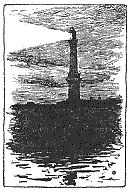
WRECKS
Here laughs and lures
the silken sea,
And widely clasps the hill-born wave;
And croons in lulling mockery
A cradle song above a grave.
ETWEEN the Girdleness and the river mouth there is
the Greyhope Bay, memorable as the scene of the most disasterous
shipwreck ever recorded in our local annals. "On the morning of the
1st of April, 1813, five whaling vessels were riding at anchor in the
roads when a sudden tempest came on from the S.E. Two of the ships
weighed and stood out to sea; but as part of the crew of one, the
ill-fated "Oscar," had been left ashore, she was obliged to put about
and keep near the land. By the time that all her men were on board she
was far inshore. Meantime the wind had died away, and from the heavy
roll of the sea, and a strong tide setting in, she was unable to clear
the Girdleness. Soon after the gale sprang up with increased violence;
it was accompanied with a dense shower of snow, and now blew from the
N.E. The vessel in vain endeavoured to ride it out; and after dragging
her anchor she was driven ashore in the Greyhope on a large reef. The
tremendous sea which broke over her threatened instant destruction,
and the only hope of safety for the crew was that of effecting a
communication with the land. For this purpose the mainmast was hewed
down in such a manner as that it might fall towards the beach; but it
dropped alongside the vessel. A number of the seamen who had clung to
the rigging were hurled into the sea along with it, many were swept
from the deck, and others who attempted to swim to the land were borne
down by the floating wreck or overwhelmed by the fury of the surf.
Only the forecastle now remained above water, and for a short time the
master and three sailors were observed upon it, imploring that
assistance which none could give. Of a crew of forty-four men only two
were saved." The bodies recovered from the sea were laid in one long
grave at the east end of St. Fittick Churchyard. Old folks still
living in Torry recall the figure of a broken old woman wandering
among the fisher huts and seeking alms at their doors. Her "all" went
down in the "Oscar," which carried her husband and three sons, and the
poor fisher folk who had seen them done to death, almost within arm's
length of help, never refuse to share their crust with the lone woman.
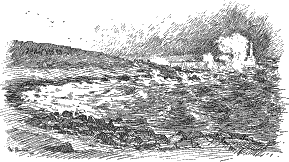
GREYHOPE.
Many another good ship has perished on the jags
which lie pitiless as sharks' teeth under the waves that lap the rocks
from Greg's Ness to the mouth of the river. One of the earliest local
wrecks of which we know recalls, in its elements of poetic justic, the
doom of Ralph the Rover, who perished on the crag from which he had
previously stolen the warning bell. Three hundred and forty years ago
a band of religious zealots marched from the south to Aberdeen;
maddened by the too palpable luxury, vice, and superstitious
observances of the priests, they were inspired by a wild desire to
sweep away every vestige of idolatry from the places of worship. Their
frenzy ever increasing as they advanced, their minds were at last
dominated by a mad desire for destruction, indescriminate and
unreasoning. Like the contagion of a plague, the frenzy fastened on
the lower classes in the town, and a wild rabble attacked the
religious houses in the city, sacking and spoiling as they went. They
even sought to drag the steeple of St. Nicholas Church to the ground.
but other citizens more sane resisted, and it was saved for that time.
Away they rushed to the Old Town, and the Cathedral was over-run by
the mad crowd. Everything that was beautiful, everything that was
breakable, everything that was worth lifting, was defaced, broken or
stolen. They tore the lead from the roof and the bells from the
steeple, and but for the timely arrival of the Earl of Huntly with
troops a broken wall might have been all left us of the goodly church
of St. Machar. But the jagged reefs of the Girdleness lay in wait for
some of the spoilers. One master robber, loading a ship with the
spoils of the church of the twin spires, the lead from the roof, and
the bells, set sail for Holland. But a storm arose and swept him on
the Girdleness, and, within sight of the church he had robbed, and in
the waters across which, in the quiet Sabbath evenings so often stole
the tolling of the Cathedral bells, the robber went down with those
bells he had for ever silenced, and weighted with the lead of the
church he had desecrated.
In 1637 the river Dee came down in spate, and drove
from their moorings by the Torry shore four vessels, one of which
contained a body of troops. A south-easterly gale was blowing which,
catching the vessels as they were swept across the bar, drove them on
the sands. The soldiers on the troop-ship were asleep when it struck,
lying on heather in the ship's bottom. Awakened by the shock and the
sea pouring in upon them in the darkness, a terrible scene ensued; a
struggle for life with the pitiless sea, and, in the panic of the
moment, their equally pitiless comrades. " Four score and twelve," the
old record tells us, "were wanting, or drowned, or got away."
But the river claims its victims as well as the
ocean. A summer rarely passes but some young life pays tribute to the
Dee. The crowning disaster on the river happened on the 5th April,
1876, when the ferry boat, on its journey to the Torry shore,
overturned with a load of seventy-three passengers, thirty-two of whom
were drowned.
It was the afternoon of a Sacramental fast-day. For
years these days, set apart for religious observance, had been
changing their character and had come to be largely spent as holidays,
and crowds of pleasure-seekers left the city to seek a change in the
woods and glens and by the sea shore. Torry had been from time
immemorial a favourite haunt of the townspeople, and on this day many
hundreds had crossed the river and wandered to St. Fittick's, the
Downies, and Tullos Hill. As the afternoon advanced the crowds seeking
the ferry became more numerous and more impatient. About three o'clock
over seventy passengers crowded into the boat before all its freight
from the south shore had been able to disembark. One poor girl, who
had just crossed from Torry, was obliged to return with the doomed
boat, and she was among the drowned. The boat, propelled by a wheel
round which a steel rope fixed on each bank worked, set out on its
fateful journey. The gunwales of the over-loaded craft were within an
inch or two of the water; the tide was ebbing ; the river, swollen by
the snows melting on its upper reaches, was in flood, and the boat was
swept down stream until the rope, stretched to its utmost limit,
formed a sharp bight beyond which the boat found itself unable to
advance. Tilting to the west side, the water began to flow in. The
passengers, who till now had been quiet and orderly, became panic-striken.
Many lept from the boat and saved themselves; but with the intention
of relieving the boat the rope was slackened at the north end. The
boat swept down, the rope tightened again and snapped, and at the same
moment the boat turned keel upwards and thirty-two of the
seventy-three passengers were drowned.
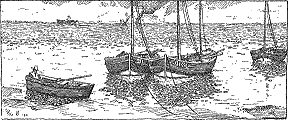
THE FERRY.
And so on down the years comes again and again the
great storm, when the sea rises, and roars, and swallows the ship and
its crew, and then the calm comes and the sea smiles and prattles with
the pebbles and fondles the seaweeds, and the loiterer by the summer
shore hears tell of wrecks that have been, but the sea is insatiable
and the by-and-by will rise up again in its fury, and claim more
victims. Many a wandering sailor, tossed dead and sea-chafed on beach
and in rock pool, sleeps in the churchyard of St. Fittick's by the
Bay, laid reverently there by the fisher folk who reck not how soon
that sea which yields them a livelihood may claim the life it
supports.
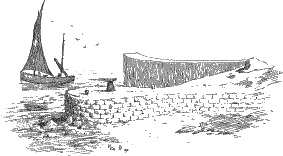
THE CAPSTAN.

TULLOS VALE
No fortress guards the
little vale,
Between the ocean and the Dee,
A church its castle on the hill,
A church its bulwark by the sea.
T is full of quiet charm, this little glen, with
its kirk on the height and its kirk in the hollow, extending from the
great gap in the cliff, which forms the Bay, up to the river, where,
with majestic bend, it sweeps glittering and gurgling by Allenvale and
Duthie Park, sweetest of resting places for the quick and the dead.
The valley is hemmed in to the south by that rigged ridge which Parson
Gordon, two and a half centuries ago, quaintly called the Grangebeen
Hills, and familiar to the city urchin to-day as " The Gramps," or
Tullos Hill. A miniature mountain chain in itself, studded with
hillocks which are its outliers, and cairns which are its peaks, and
for tarns and lochs the little water-filled hollows choked with water
sedge and cinquefoil, and carpeted around their swampy margins with
the green and crimson plush of bogmoss and sundew, a carpet spangled
with the orange stars of the bog asphodel, and beyond that the heather
and whin, blazing in bloom of gold in spring, dark green, and purple
in the fall, whilst a strip of woodland
"That just divides the desert from
the sown"
|
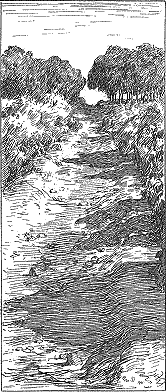
THE OLD KIRK
ROAD. |
yields a succession of greens throughout the year.
For there, while the snow still covers the distant Mount Battock and
Lochnagar, seen white from this hillside, the dainty tassels of the
larch swing out in the spring winds sprinkled with the rubies of the
young cones ; then comes the darker birch, and last of all, along the
old hill kirk road, the beech unfolds its fragile leaves, most
brilliant of woodland greens, and over all looms the gloomy fir as
surly to the touch of spring as it is sullenly unyielding to the
season of frost and tempest. Tullos Hill was planted in 1799. The
trees flourish along its northern border, but have almost disappeared
from the rest of the hill. The access to it is by an old road entering
the hill east of Tullos House by the beech row, but soon lost in whin
and bramble; one branch of it used to go straight south over the hill
to join the road to the coast, the other turned to the right, and
winding westwards, by the elf hillock, led to the Church of Nigg. What
is left of this old kirk road is now as waterworn and rugged as the
dry bed of a torrent, and bordered with a tangle of rasp and rose,
bramble and honeysuckle. Near by, where it used to wind westwards,
there are some curious circular trenches long hidden among
impenetrable whin, but revealed by recent hill fires. Immediately
behind Tullos House, on the borders of the wood there is the curious
mound known as the Elf Hillock, now covered sparsely with trees. This
is doubtless a place of sepulture. To the west of the hillock there is
a little crossing, long called " The Fairies' Briggie," for the keener
fancies of our forbears saw here a fit meeting-place for the children
of the moonlight, the local representatives of Oberon and Titania, and
Puck, and many another merry elf. Joseph Robertson conjectures that
our Elf Hillock may have been the scene of a fine ballad given by
Scott in his Minstrelsy of the Border, and reproduced in this book.
Beyond the strip of woodland, the hill on its
western half is chiefly covered by dense whin, which springs up
rapidly, and year by year is still more rapidly destroyed by the
frequent fires which careless folk kindle on the hill. From the old
road as it enters the hill a path winds up to a great cairn of stones
set on the sky-line; this is the Baron's Cairn. The stones are now
scattered about by many a young vandal, but formerly they were laid
down with care and regularity. It was at this cairn the beacons were
lit to warn the warders at the harbour that an enemies' ship
approached, in order that the river mouth might be closed by the great
boom, and that the block-house cannoniers stand to their guns. The
foundations of the watchman's house are to be seen close by the
Baron's Cairn. Further west there is another great pile, "The Cat's
Cairn," also on the sky-line, and at the east end of the hill a
smaller cairn stands, " The Crab's Cairn," while on the northern face,
N.E. of the Baron's Cairn, and far below the sky line, there is a huge
stone heap known as the "Tullos Cairn." These cairns were probably
intended to be commemorative of great events in the sturm und drang of
the fierce old days. The monuments remain, characters of a lost
tongue, the signification of which we cannot decipher. The cairns were
of great importance to the old navigators, and we find the most
precise directions given for employing them as guides and landmarks,
but it is very unlikely that they were originally piled up for this
purpose any more than were the twin spires of Old Machar Cathedral,
which were also taken as leading points by sailors. Between the Tullos
and Crab Cairns there is a hill-well, far removed from all source of
contamination, called Jacob's Well, a rillet from which soaks through
a little valley, among the bog moss and pennywort and sedge, to
collect in a neighbouring hollow as a broad reedy pool. Along the
course of this water trickle a kind of rush known as "sprots'' grows a
fine annual crop; these werel argely used for "raips" and thatching.
The harvesting of the sprots used to exercise to the utmost the
ingenuity and "slimness" of the farmers of Nigg. The sprots are
useless until mature, so the neighbouring agriculturalists kept a
jealous eye on their growth, each man resolving to reap those sprots
for himself as soon as they were ready. Mr. X. and his men stole out
one moonlight night and with stealthy scythe cleared the little hollow
and set the sprots up in stooks, to carry home at day dawn. Home they
returned in the night, hugging themselves in satisfaction at their
strategy, and after a brief sleep returned with daylight for their
hill harvest. But Mr, XX., a rival sprot seeker, who slept while they
reaped, had risen an hour earlier to cut the much coveted rushes, and,
finding them ready stocked to his hands, gathered them up in
thankfulness of his neighbour's industry.
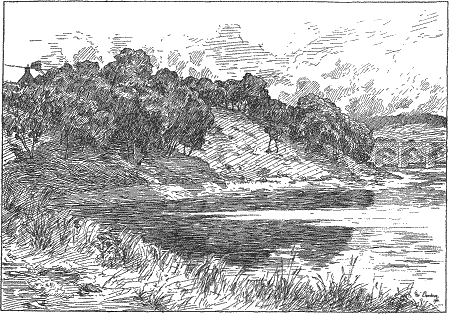
CRAIGINCHES WOODED BANK.
The "Cheerful Vale of Tullos," as it is called in
an old survey, is the subject of a persistent tradition that once upon
a time the Dee flowed there. Another tradition has it that a Dutchman
long ago offered to lead the Dee down this way, and still more firm is
the current belief that it will yet seek the sea in the Bay of Nigg,
when
"Doon Tullos haugh, 'mang biggins
braw
Rolls in her royal course the Dee,
And lingering, limpid, silent, slow,
From Allenvale seeks to the sea."
But no longer is the Tullos hollow the undisturbed
retreat of farmer and fisherman. It is now the main artery of
communication between north and south and daily and nightly there
thunders along the erstwhile quiet valley train after train in quick
succession, laden with men and merchandise from the south and carrying
the produce of the fertile fields that stretch northwards from the Dee
and Don, and the sea harverst gathered by the famous fishing fleet of
Aberdeen.
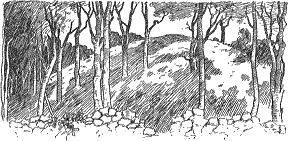
ELF HILLOCK.
From the Baron's Cairn we no longer scan the sea
for the men of war of our "auld enemies of England," nor for the
hostile cruisers of France. Old Mrs. Greig, who lived into our day,
would tell how she once saw, from the watchman's house by the cairn,
during the great war with Napoleon, a French privateer chasing a
British ship along the coast and firing on her, but to-day the
prospect is peace, or but the warring of the elements when the sea is
vexed and the firs roar on the hill.
"When the wind, the grand old Harper,
Smites his thunder harp of pine."
From the old watch-house by the cairn a glorious panorama is spread
out, South and East and North and West. Eastward the brown heath meets
the blue sea, and beyond that sea and yet more sea, until the blue is
the blue of the sky. Away to the North,
"Gazing north we see the water that
grows iron round the pole,
From the shore that hath no shore beyond it set in all the sea."
on its peninsula the Girdleness Lighthouse lifts
its beacon, and from the high ground there, now "The Torry Park," a
prospect of sea shore of wonderful extent presents itself. Professor
Masson, writing of this part of the coast in 1871 said: "I think I
have never seen anywhere else so vast an arch of open sea. Eastward
you gaze. Not an island or a headland interrupts the monotony of
waters to the far sky-line; and you know that beyond that sky-line you
might sail and sail, still without interruption till you reached
Denmark or Norway."
You cannot see the Deemouth from the Cairn, but
Futty is there by the water's edge, and thence, like a great bow, the
yellow sands of Aberdeen Bay sweep northwards in a curve that might be
the mould of a rainbow. Banked with bent and frilled with breakers,
the beach stretches by Donmouth, the Black Dog, and Belhelvie, with
its line of Coastguard houses set white and black on the yellow
ground, until it slips from sight where sea-shore and sky meet, and
where, when night falls, the lights of Buchanness are seen to flash
and fade in the darkness. From the hollow by the shore rise the spires
and towers of the white city, ever steadily creeping over the fields
northwards and westwards. The Deeside Valley leads up to the distant
hills from which, on a clear day, stand out the splendid masses of
Mount Keen and Lochnagar, and overhead, as evening falls o'er Tullos
Hill, the sea-mews are hoarsely calling as they seek the cliffs after
a day's foraging on land, when
"Sail on sail along the sealine fades
and flashes here on land,
Flash and fade the wheeling wings on wings of mews that plunge
and scream."

THE OLD ESTUARY
Where yester day the
field were ploughed,
And cattle strayed, and trees were green,
To-day, in dinsome streets, a crowd
Of bustling city folks is seen.
ULLOS hollow is enclosed to the north by the high
ground extending westwards from the Torry Park, parallel with the
river, and ending in the pretty wooded bank that stoops abruptly to
the river's brink by the Suspension Bridge. On the northern slope of
this ridge, where but yesterday stood a decaying farm-house with its
"green mantled pool," overhung by old willow trees, there stands
to-day a new town, with spacious streets, high buildings, and a
bustling traffic; a transformation as rapid and complete as if, but
lately, the wonderful Lamp of Alladin had been rubbed up in Old Torry
Farm.
There were fisher folks in Torry, as surely as
there were fish in the bay, long ere Aberdeen had houses enough to
make a street, and long ere centuries of making, and buying, and
selling, and eager learning had evolved that level-headed race known
to the world as Aberdonians. In fancy we may conjure up the scene that
presented itself to the prehistoric Torryman, as he returned to his
hut by the mouth of Dee, after a day of limpet-gathering about
Girdleness, by way of the shoulder of the hill we now call the
Greyhope road.
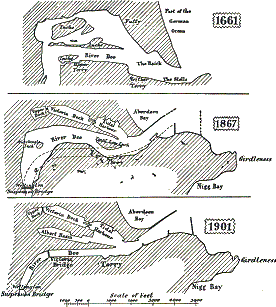
ABERDEEN HARBOUR—1661,
1867, 1901
The dotted lines in the
middle figure indicate the last diversion of the river.
The tide is full, and the sun is seeking the
western hills that loom up beyond the land where the river comes from,
untraversed by the fisher folk, and full of fierce, roving tribes, the
echo of whose feuds and battles reach the dwellers by the river mouth
but rarely. From the Torry shore a vast sheet of water spreads
northwards and westwards : the lands we now know as the Links and
Footdee are not yet above the sea, which laps the base of the
Castlehill, entirely covering that space now occupied by the low-lying
streets between its base and the Quay, Virginia Street, James Street,
Commerce Street, etc.; it reaches the foot of St. Katharine's Hill, up
which the Shiprow now winds and Market Street ascends. There is sea
over the site of the station to the base of the steep ground that
descends from Crown Terrace to the level of the Denburn, where now the
railway is laid, and it stretches a narrow arm over the site of Dee
Village, along the gorge between Ferryhill and Springbank Terrace to
expand beyond into the Loch of Dee. The river, emerging from the
forests and marshes of lower Deeside, enters this broad estuary at the
Craiglug, where now the Suspension Bridge spans the river.
From the northern shore of this inland sea a series
of forest-clad hills and marshy hollows stretch away to where Brimond
fills the sky-line, with many a brook winding through the bog and
among the eminences destined to be the site of that fair city, which
yet sleeps bound in the granite heart of the hills, for the iron is
not yet forged for that magician's wand — the chisel — at whose touch
the rocks will open, and the white city will bourgeon like a flower.
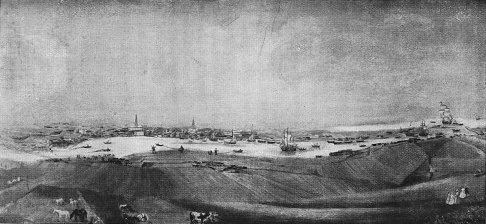
TORRY IN 1756.
From the picture by
Mossman.
Such is the scene we fancy ere written records aid
us, told by the flint weapons, the human bones, the gathered shells,
and trunks of oak, and birch, and alder dug from under the present
land surface, buried deep under deposits of sand, and clay, and
gravel. When the light of history begins to glimmer, the scene that
presents itself still differs greatly from that which we see to-day.
The sand, blown by the wind and drifted by the sea, and the mud
accumulated by the river, have formed the Links and Footdee, and laid
down a fringe of low-lying ground along the foot of the shore hills
from Castlehill in the east to Ferryhill in the west; ground mostly
covered at full tide but low muddly flats in the ebb.
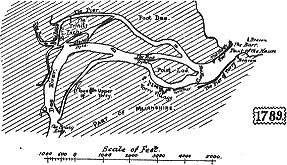
THE HARBOUR AT LOW
WATER.
The Dee, issuing through the Craiglug narrow,
spreads away northwards, skirting the Ferryhill and Clayhills,
spreading over the shingle, where now stands the Station, and then
eastwards among the mud-flats that line the north shore. When the tide
was full a broad firth stretched from Torry to this north shore, with
a few green islands, called the Inches, appearing above the water, the
larger of which were occupied by the huts of the salmon fishers, and
grazed by cattle. At ebb tide a network of narrow channels among sandy
shoals and mud-banks lay between Torry and the City. How different the
scene to-day, with the water confined into definite channels—the
docks, Albert basin, and the river. The old mud-flats are reclaimed
from the tide, the main stream of the river is diverted into a new
channel, and where once the fluke and the saith swarmed in the
shallows and the crabs squattered in the mud, we have to-day busy
thoroughfares, bustling factories, and deep-sheltered docks crowded
with all the various craft the sea carries.
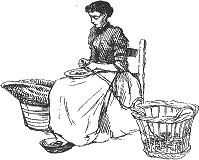

TORRY OF OLD.
Where saw those dwellers
by the shore
The Norsemen sail across the bar,
And later heard the cannon roar
From thundering English men-of-war.
UCH was the broad firth into which the fisher folk
of Torry saw the Norwegian Sea King Eystein enter with his fleet over
700 years ago. Shouting the songs of a thousand sea fights, these
wolves of the wave pulled for the north shore. There was little to
tempt them in the fisher huts of Torry, but the City of Apardion, as
Aberdeen is called by the Northern poet who commemorates the event,
was already of such repute, in wealth and importance, as to attract
the avaricious and ruthless Norsemen. The Torry fisherman, safe in his
poverty, could hear, across the firth, the clash of arms and the
shriek of victims, for the Vikings spared none who opposed, and when
the struggle was over, and the glutted pirates sailed from the mouth
of Dee, the trembling fisher folk saw the flame, and heard the roar
and crackle of a burning town.
"I heard the overthrow of people -
The clash of broken arms was loud,
The King destroyed the peace
Of the dwellers in Apardion."
S o sings Einarr Skulason, the Norwegian bard.
Eighty-nine years after Eystein the Viking sailed
past the doors of Torry, we hear of an event of great importance on
the south side of the river. In 1242 the Church of St. Fittick by the
bay was dedicated by Bishop David of St. Andrews, and there is reason
to believe that part of the walls now standing are the very stone and
lime blessed by this holy man over 600 years ago. For nearly two
centuries after this event the local annals are almost vacant. Out of
the meagre vestiges of vanished records we learn that about 1430 a
greedy clergyman, the Vicar of Nigg, was excommunicated by the Bishop
of Aberdeen for exacting the tithe of fish within his Vicarage. Greedy
Vicar! Blessed Bishop!
For half a century after the dedication of The
Church of Nigg, more especially during the reign of Alexander III.,
the fortune of Scotland was brilliant and steadfast, but King
Alexander died without heir, and jealous factions wasted the country's
strength and gave the masterful King of England his long wished for
opportunity to push his ambitious schemes for the subjugation of the
northern kingdom. Baliol, his puppet, on his first attempt to oppose
his master, was swept aside, and Edward of England rapidly advancing
northwards, crossed the Dee and came to the Castle of Aberdeen where
he tarried five days and then returned to the South, leaving a
garrison at Aberdeen. It was then that William Wallace rallied the
Scots and marched over the ground Edward had taken, retaking the
strong places, among others Dunnottar, and then North by Torry to
Aberdeen, where the Castle was garrisoned by English troops, and by
the Torry shore lay many English ships, with men and supplies. The
English set the town ablaze and fled to their ships, but the water
could not save them from the indomitable Wallace. Manning every boat
by the Torry, Futty and Aberdeen shores, he attacked the English in
their ships, sweeping some of them clear of every living thing, while
others, crippled and terror-struck, stood out to sea, and so once more
the clash of arms, the shout of conflict, and a blazing town is
witnessed from the Torry shore. By-and-by, in nine short years, Torry
witnessed another passing of Wallace, not, alas, in martial panoply
and flushed with victory over the invader, but a mangled limb hurried
from a London scaffold to rot on the Justice Port of Aberdeen — but
that could not be — when night fell on the city the limb was taken by
patriots from the town gate and carried across the river to the old
churchyard by the bay, and tradition points to its S.E. corner as the
spot where the dust is, in part, that of Scotland's Hero.
The 11th December, 1495. was a red-letter day in
the history of Torry, for on that day King James the Fourth of
Scotland granted a charter constituting Torry a Burgh of Barony, for,
among other reasons, the great devotion in which he held St. Fotin
(another of St. Fittick's aliases), the Patron of the Town of Torry,
and for the convenience and support of wayfarers, whether foreigners
or the King's lieges, lodging in Torry, who, crossing the mount
(Grampian Hills) towards Aberdeen, might be unable to pass by reason
of storms or tempests. The privileges conferred by this Charter on our
village were great in those days of fettered trade. They were the
power to sell and buy wines, wax, various cloths, and other kind of
merchandise ; liberty to have bakers, brewers, and fleshers; power to
appoint Burgesses in the Burgh ; and power to elect Baillies and all
other necessary officers ; and, lastly, license to have a cross, a
weekly market on Friday, and a yearly fair on St. Fittick's Day, the
30th of August, and the four following days. This Charter carries us
back to times long before the Reformation, when the Church owned vast
tracts of land, and Churchmen were mighty rulers in things temporal.
At this time Torry, with all the lands of Nigg, belonged to the Abbey
of Arbroath, that powerful ecclesiastical seat on the east coast, the
Abbot of which had "a seat here with a dovecote near the Church of
Nigg." In that interesting map of the lands of Torry, made in 1777 by
George Brown, and preserved in the Town House, we find fields adjacent
to the old Church named the upper and lower dovecote fields.
These lands were granted to the Abbey by one of our
Alexanders, and were held by the Abbots up to the Reformation. Before
this event, however, a portion of the Torry lands had been feued to
Menzies of Pitfoddels. After the Reformation the whole of the Nigg
lands passed to Forbes of Monymusk, who, however, had to observe the
rights conferred on Menzies by his feu. In 1704 the Town Council of
Aberdeen purchased part of the land from Forbes of Monymusk, so that
from the beginning of the eighteenth century, the town of Aberdeen and
Menzies of Pitfoddels were joint proprietors of the lands of Torry.
There was at this time an extraordinary system of holding land, called
"runrig," under which the various proprietors possessed their land,
not in one compact or continuous area, as at present, but rig and rig
about with each other, the alternate ridges of the fields belonging to
different proprietors, and farmed by different tenants. From 1704 till
1785 the Town and Menzies ran rig for rig, but the increasing
inconvenience of this barbarous system called forth an Act of
Parliament, under which it was possible for an owner to claim to have
the lands divided in a more reasonable fashion by an arbitrator. In
1785, therefore, such a division took place between Pitfoddels and the
Town, and the Town got all the land lying east of the line, from about
the Mansfield Road to the Bay of Nigg, whilst Menzies got all the
lands of Nigg. west of this line, a much greater area, and to-day of
great agricultural and feuing value, but it is necessary to remember
that at the date of division most of this western portion consisted of
unreclaimed bog and moor.
Westward from Torry, near the old Bridge of Dee,
stands the farm of Abbotswalls, the name of which carries down to us a
reminiscence of the old ownership of the Abbots of Aberbrothock. Near
Abbotswalls there was a chapel and burial-place, the ruins of which
are recorded as visible towards the end of the 17th century, while the
old name of the burn, which enters the Dee opposite Duthie Park, "the
Spital Burn," suggests the hospital or lodging for pilgrims, which
once stood on its banks.
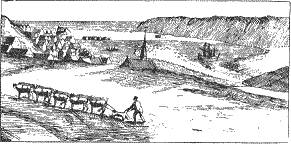
EARLIEST VIEW OF THE
HARBOUR, DRAWN IN 1661.
Returning to the granting of the Torry
Charter—Those were the days when men wandered to distant shrines and
holy-places for their soul's sake, and un-bridged rivers were
obstacles to their journey of which now-a-days we little dream.
Pilgrims passing northwards, ere they reached the Dee, had to traverse
long tracts of dangerous bog and moorland stretching away down through
Kincardineshire and Forfarshire, with roads only a little less
dangerous than the bogs, and when at last the terrors of this route
were overcome and they had reached the brow of the Tollohill—for then
the south road lay further to the west than at present—and they saw,
like a promised land, the city on its three hills; at the same time
they often beheld a flooded river and a storm-swept estuary which no
boat dare cross, and on the southern bank, scattered near the chapel
of those days, the huts of Torry offering but scant accommodation to
the wearied pilgrims. Hence the privileges granted by King James at
the intercession of the good Abbot of Aberbrothock. But from the day
the Charter was signed we hear no more of the glories destined for
Torry. Its Baillies await election; its market days and annual fair
are in the future; and its cross has yet to be raised. But when we
remember that a few years after the granting of this Charter Bishop
Elphinstone began to build the great bridge across the river now known
to us as the Bridge of Dee, completed in 1525 by his successor, Bishop
Dunbar, and that over it passed the highway between the Tay and
Aberdeen, we can see that pilgrims needed no longer to go to Torry for
the passage of the river, but fair weather or foul they might trudge
dry shod into the City over the Bishop's Bridge—and so, as yet, we
have heard no more of the independent glories of Torry.
But if Torry never got its Baillies, it was at one
time the residence of the Provost of Aberdeen, as witness this extract
from the Council register, of 30th September, 1594 :—" The said day,
the Council having consideration that John Collysone, quha is elected
provost of this burght for the year to cum, hes his present dwelling
in Torrie, and that for his diligent avating on the said office, he
may transport himself, wyff, bairnis, and famelie to this burgh, and
dwell therein during the time of his office," provision of a house, at
the expense of the town, is made for Provost John Collysone.
For over a hundred years, from 1590 to 1660,
looking across the water to the Heading Hill, the folks of Torry often
saw a cloud of smoke by day and a pillar of fire by night. The
Aberdonians were in arms against the Devil, and were burning, in mad
zeal, poor, frail, human wretches, more wretched, more ugly, and more
helpless than their fellows, or, in some cases, possessed of an
insight and wisdom that their station in life did not seem to warrant.
Swept to the stake by the fury of a frightened superstition, this poor
human rubbish — witches, they called them ! — was burned up or
tortured, and dragged through the streets, under the commission of the
King and the superintendence of the Magistrates. Professor Masson,
with reason, calls the Aberdeen of this period the witch burningest
place in the world ; but for the sake of variety they sometimes
drowned the unfortunate old women ; and at the foot of the Shore Brae
they erected a crane, by which they lowered the struggling victims
into the tide to wash away their sins with their unhappy lives.
THE RIVER MOUTH
Though Canute's voice
was to the sea
Far less than idle, whistling wind,
Great Smeaton's thought had potency,
The reckless, storm-stirred wave to bind.
HREE hundred and fift years ago there was much
ferrying to and fro between Futty, as it was then called, and Torry.
There was no north pier in those days, and the point from which the
north pier now starts was a low, wind-swept sand dune, called the
Sandness, and the houses of Futty stood further west by the waterside,
near by where to-day we see St. Clement's Church. On the Sandness, at
this time (1513—1542), a fort, called the Blockhouse, was built, which
stood there till a few years ago, its purpose being to protect the
harbour from " Pirats and Algarads," as Parson Gordon puts it in 1661.
(It was furnished with ten cannon, 12-pounders, which were removed to
the Torry fort after the erection of the north pier.) The mouth of the
Dee was locked by a boom, made of chains of iron and masts of ships,
stretched across the river mouth. On the Torry shore, on the braehead
opposite the Blockhouse, there was also a little watch-tower, with a
bell and a sentinel, whose duty was to ring the bell on the approach
of any ship, while a watch of four men was set "at Sanct Fathatk's,
beyond the water, to have ready fyre and stuff to mak blaise," and
other four at the "Cunnynger Hills, for resisting of our auld inemeis
of Ingland."
It was at Torry, in the very channel of the river,
that men-of-war and great merchant vessels lay in those days, for the
shallow harbour, where are now our great docks, was useless for big
craft. Smaller vessels got the length of Futty, and only at high
water, and with the help of the tide could they pass up to Aberdeen,
where they lay high and dry in the ebb.
About a hundred years later, the interest of Torry
was excited by a new undertaking on their side of the water. Nothing
of consequence, until this time, had been done to improve the
condition of the river mouth, which was narrow, shoaly, and dangerous.
"During the usurpation of Oliver Cromwell, a mound was formed in the
harbour basin, which contracted it considerably on the side of the
town," but in 1607 a long pier or bulwark was erected on the Torry
shore opposite the Sandness of Futty. The inhabitants lent a willing
hand to this undertaking, and a great bulwark of uncemented stones and
timber was built up. This work was no humdrum task, but a festival of
labour, for the town pipers and drummers marched by the shore, and
cheered the toiling crowd, and for once, at least, in those fierce old
days, the drum beat and the war-pipe shrilled an advance along the
paths of peace. From time to time this bulwark, ravaged by storms,
needed repair, and we read that on one occasion, in 1707, part of the
timber of a Dutch boat, wrecked at the " Black Dog," was employd to
renew it. This pier stood by the Torry shore till about 1810, when it
was entirely taken down. Baillie Skene, writing in 1685, says,-"that
considerable bulwark the Magistrates of late years caused erect at the
mouth of the southside of the river ; extending up the shore such a
great length ; so that very great ships may enter and be safely
preserved when they are in without hazard." Torry was more than a mere
fishing village then, when the great vessels lay by its shore, and
much loading and unloading was done on its bulwark or pier. However,
when Smeaton, the great engineer, examined the river mouth, with a
view to the improvement of the harbour, he condemned the "bulwark," as
not only affording no protection, but being mischievous in abruptly
meeting the storm-sweep from the north-east, and causing a recoil and
disturbance along the harbour basin, while Rennie, the Harbour
Engineer of that day, considered that the Torry bulwark led to
increased disturbance in the harbour waters, and that its only
advantage was to support capstans to pull in ships in westerly winds,
and by narrowing the channel, to increase the sea-going river current,
and thus aid in scouring the bar.
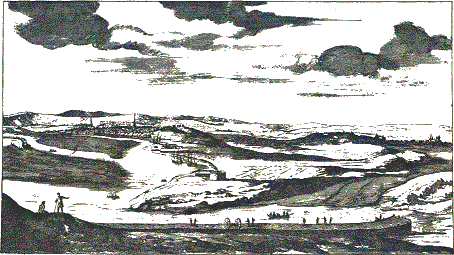
THE TORRY BULWARK
(1607-1810).
From Plate in Slezer's
Theatrum Scotiæ, 1693.
Early in the seventeenth century, about the time
the bulwark was completed, another undertaking, of great importance to
navigation, was completed. The harbour mouth had been long blocked by
a huge stone, called "Knock Maitland " or " Craig Matellan," which had
been the stumbling block and despair of harbour improvers. But there
arose in those days a genius to whom difficulties were joys, and the
impossibilities of other men as the breath of his nostrils, and the
people acclaimed the advent of this great man, and, in the fulness of
their admiration of his wonderful powers, they named him "Davie do
a'thing," but his prose name was David Anderson of Finzheuch. David
gathered together a lot of empty barrels, and fixed them securely, at
low water, to the base of the obstructing rock, then, planting a flag
on its summit, and seating himself as on a throne, he waited for his
servant, the tide, which, in its due time came, and lifting Davie and
the rock, buoyed on the bowies, carried them westwards, amid the
acclamations of the citizens.
Twenty-seven years after the removal of this
obstruction, the good folks of Torry witnessed another period of
excitement, but with consternation in place of rejoicing. The bar was
at all times shallow and dangerous, for at the period we speak of
there were only two feet of water on it at low water, and no more than
ten feet at neep tides. In 1637 "a great bed of sand was casten over
it, mixed with marl, and clay, and stones, so that no ship could go
out or come in, and at low water a man might have passed over,
dry-footed, from the north shore to the bulwark. It amazed the haill
people of Aberdeen, burgh and land ; they fell to with fasting,
praying, mourning, weeping, all day and night "—this didn't shift it."
Then they went out with spades and shovels, in great numbers, young
and old, to cast down this frightful bar, but all in vain, for as fast
as they threw down at low water, it gathered again at full sea. Then
the people gave it over, and became heartless, thinking our sea trade
and salmon fishing was like to be gone, and noble Aberdeen brought to
destruction, and hastily advertised the haill coast-side, south and
north, of this accident, that none of their ships should approach the
harbour. But while they are at the point of despair, the Lord, of his
great mercy removed clean away the bar, and the water did keep its own
course as before."
It seems curious now-a-days to have our sea trade
and salmon fishing mentioned as of equal importance, but the shipping
in those days was insignificant compared with its present state, while
the salmon of Aberdeen were abundant, and were accounted in France the
best in Scotland, and France was then our great market for this prince
of fishes. About 200 years ago the Dee and Don fishing's supplied
about 1500 barrels of salmon, each barrel containing about 250 lbs. of
fish; about the year 1782 we are told that the supply had increased.
At this date, in the first six months of the year, the salmon were
boiled and kitted for the London market, and sent off every week by
swift sloops retained for the purpose; those caught throughout the
summer were salted for exportation to Holland, France, and Spain. A
century ago, in the fore-end of the fishing season, if any of the
inhabitants wanted salmon for their own table, the preservers were
bound to supply them at threepence the pound. That our salmon were
estemed at home we may gather from an entry in the Burgh Accounts of
1581, from which it seems they had a more homely way of " providing "
a " deputation " than by granting a blank cheque- " The secund day of
January, boycht at the command quhilk was sent to the Clerk of
Register for his travell in the tounes efferis, payt for the same
£18." From these accounts we also learn that the shipping of these
salmon was from "Torry—" tem payt to the boy of the boitt to bring the
barrell to the boitt frae Torrie schoir."
The great obstacle to the safe and easy navigation
of the harbour entrance was " The liar"—a bank of sand and mud
extending across the mouth of the river, accumulated by northerly and
easterly winds, and the tides, and by the denudation debris brought
down by the river. At low water there was formerly only two feet on
the bar, and, besides this main bar, there were many sandy shoals of
so shifting a character, that navigators complained that, on returning
from Aberdeen, they could never find the harbour mouth as they left
it. The end of the eighteenth and greater part of the nineteenth
centuries, witnessed a continuous and resolute endeavour to enlarge
and deepen the harbour, and render its entrance easier and safer, for
the prosperity of the city depends on the condition of its harbour. To
see what success these efforts have achieved, we have only to compare
our deep and crowded docks to-day with the shallow pool in the estuary
of the Dee, which small craft entered with difficulty two hundred
years ago.
In 1780, after two years' work, the first stretch
of the North Pier was built, with the object of protecting the harbour
mouth from the wash of north-east winds, and tides, and the consequent
banking-up of the bar, and with the object also of narrowing the
stream, so that the increased current would carry the deposits
seawards. This first step immediately gave five feet of water on the
bar at low tide. This plan was the idea of Smeaton, the famous
engineer, whose reports on the subject are models of conciseness and
lucidity. In a report, dated 1770, he says—"I cannot but lament that
the course of the river is distracted by so many channels, and covers
so great a breadth of ground at high water." In 1789 the jetty at the
base of the North Pier was erected to break the run of the sea along
the pier. In 1870 the pier was extended nine hundred feet seawards,
and at that date the Torry bulwark was taken down. In 1874 the final
addition was made to the length of the North Pier, which then reached
its present length. The old South Breakwater was completed in 1815,
and curtailed in 1874, when the new South Breakwater was completed,
built of great concrete blocks made at Greyhope, the stones for which
were largely taken from the Bay of Nigg, and the removal of which so
greatly altered the character of its shore.
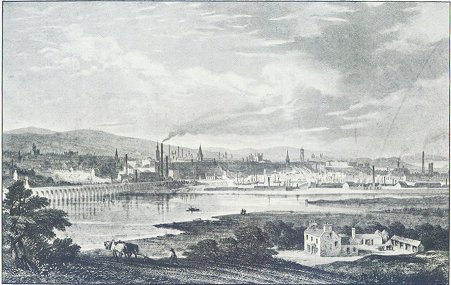
TORRY FARM ABOUT 1850.
And so century by century the Torrians marked the
changes which the energy of their neighbours, across the river, was
effecting on the face of Nature. The thatched huts disappearing, the
great white stone buildings gradually covering the hills that rise
from the North shore, steeple and tower shooting up—the efflorescence
of the growing city —a fine span cast from height to height across the
Denburn Valley, the slimy tide-washed mud flats and shingle reclaimed
from the ebb and flo and the waters walled in by massive quays to form
deep and spacious docks, whereby the great ships might reach the city
and lie scatheless of sea-storm or river flood. The fishing village
benefited by the prosperity of its great neighbour, but, itself,
changed little during the centuries. Conservative in habits, and
mingling little with the world beyond their village and shore, except
for purposes of barter, the fisher folk lived on from generation to
generation, simple in their lives, unvarying in their habits,
rejoicing when the boats returned low in the water, wailing in ever
recurring sorrow when they came back wrack-torn with some son or
father missing.
THE FISHER FOLKS
In vain for him the
colours gleam
On lifting wave and shredded spray,
As wearily against the stream
The night-spent fisher pulls his way.
|
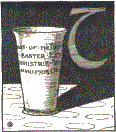
MAITLAND'S COMMUNION CUP, 1703. |
HE old village of Torry, from its proximity to a
city active in the making of history, has a more vicissitudinous story
to tell than the other fishing village along the east coast. Of a
distinct race, unchanging in their habits, mixing little with the
landward people, except for purposes of trade; yet the neighbouring
port, with its foreign-going ships, drew many a fine lad from home,
and many a fisher-girl became the wife of a city worker. The village,
thus drained, had many ups and downs in its population. At one time
crowded with white-fishers, and another the race of fishermen almost
gone, and, in their place, a considerable population of working people
from the shipbuilding yards and other city industries. In the days
when the famous Aberdeen clippers were being built, two ferry-boat
loads of carpenters passed, morning and night, across the harbour
mouth, to the yards, from Torry, which was the home of the carpenters.
These men were clothed in characteristic white suits, and their coming
and going was one of the sights of the harbour mouth. By-and-by came
an influx from the villages, north and south, Slains and Colliston,
Cove, Skateraw, and Portlethen, and the fishing population again
reached its old limits; but to-day the descendents of families who
have lived in Torry for three generations may be counted on the
fingers of a man's hand. Two hundred years ago we find Torry looked
upon as a considerable fisher-town, having six boats for great fish,
besides lesser ones. Later, when Dr. Cruden of St. Fittick's wrote his
account of the parish in 1793, there were 36 men in 6 great boats,
besides the old men and boys in numerous yawls—Cove at that time
having 24 men in 4 boats, and 14 young and old in yawls.
In 1839 Joseph Robertson, the historian, describes
Torry as a "small village, inhabited by a few families of
white-fishers," While the Rev, Mr. Thorn, the last Minister of St.
Fittick's Church, and the first in the present Church of Nigg, tells
us that, in 1843, the population of Torry was 370, at which period the
fisher population had dwindled, having only 3 large boats, with 6 men
a-piece, the majority of the people being workmen from the city. There
was a considerable ship-building industry in Torry about this time.
The yards were situated where Wood Street now stands, and it was here
that the first hoppers were built in connection with the dredging of
the harbour.
The fisher folks are a serious-minded race, living
perpetually in an atmosphere of anxiety. All through the season of
storm their women folks live in a state of high mental tension, and
the effect of such an ever- ecurring strain permeates and dominates
the character of the race. To the landward man "the wind bloweth where
it listeth," but to the fisher folks whose bread winners in their
little boats are at the mercy of the capricious breeze, the wind has a
fateful language, at times helpful and cheering, at other times
threatening and ominous. They are a thoughtful people, slow to acquire
new ideas, but tenacious of those acquired by experience and
tradition. Thoughtful, they are necessarily a religious people. The
great lonely sea, as they know it in the night and at dawn, kindles
that primitive feeling of awe and reverence which is the basis of the
religious feeling. The sea, winter by winter, brings them face to face
with danger and death, and, winter by winter, some father, or son, or
brother comes back from the sea no more. So the idea of the world
beyond, where there is no sea and no storm, is ever present with the
fisher folks.
What a life of unceasing toil and anxiety was
theirs before the days of railways and other facilities. In a
description of the east coast, written about 120 years ago, it is
remarked that "the town's people complain that their fishers do not go
far enough out to sea, where they would find larger fish ; but the
truth is the poor men go so far, that they too frequently never
return." The same writer remarks that the town is only partly supplied
by Torry and Futty, and that large supplies reach it from the villages
north and south. " They are even brought from the Newburgh, ten Scotch
miles distant, upon women's backs, in baskets. One cannot, without
pain, think of a poor woman travelling fifteen English miles before
breakfast, with a heavy load upon her back, and yet, were you to
express your feelings to her, she would smile, and tell you that she
wished she had only fish enough to carry! Such is the force of habit,
that they would think it a punishment to be obliged to return home
with an empty basket. If they have neither goods nor provisions to
take home, they generally put stones in their baskets, about a third
of the weight they take in."
Lately the writer heard old Mrs.______ reproving a
young lass for complaining of some little duty to be done—"Lassie, ye
dinna ken fat it is to be livin'. When I wis your age I had tae start
fae Finnan, wi' a birn that took twa tae lift on my back, at three
o'clock on winter mornin's, wi' the blin' drift i' my face, an' tramp
in tae Aberdeen by the Brig o' Dee road, which wisna sae steep nor
slippy as the Suspension Bridge road; then a' foreneen i' the Market;
syne we filled oor creels wi' groceries or mussels, an' startit hame
in the aiferneen, and eh, sirs, it wis a stiff road hame. On the
frosty nichts we ees'd tae pick the middle o' the road, where the
horse feet had chippit the ice, but files the hill wis sae slippy we
had tae tak the ditches, an mony a nicht the tangles on oor frozen
petticoats wad hae oor legs cut an' bleedin' an' frozen again, afore
we wan hame. Then there wis the fish to carry up the lang steep Finnan
braes, the mussels tae shell, an' the line to bait, the fish to clean
an' smoke, syne the hoose tae tidy up, an' the bairns tae look aifter,
an' awa tae Aberdeen again. Eh lassie! lassie! mony a week oor een
never steekit on a pillow ; an' in the simmer time, besides the ither
wark, awa tae the moss, three weary miles, tae cast peats, an' when
they were dry an' ready, to carry them hame again, Lassie, dinna
complain o' your bit wark bein' a fash."
But the old order changes, the steam which brings
tons and tons of rich food every morning from the deep sea, is
breaking down the old seclusion of the fisher folks. A process of
centralisation goes on apace—the villages are pouring their peoples to
the great fishing port, and although some folks cling to the old boat
and the old home, a generation or two hence and the peculiar race of
our North-East Coast Fishermen will be merged in that new race in the
process of evolution on the Torry braes, where the glib tongues of
Englishmen and Englishwomen mingle with the broad Doric of Aberdeen
and Kincardine, and many a young Scotch man is choosing his mate from
among the English "incomers," and many a young Englishman marries a
Scotch lassie; and in the houses a dialect new and strange is
developing, where words peculiarly Scotch are tripping from English
tongues, which give a special flavour and piquancy to the language
they find so expressive; and under the shadow of the Baron's Cairn,
where once was set the watch for "oor auld enemies, the English,"
these erstwhile enemies mingle in the common industry, and crowd with
a new race the streets that daily are stretching across the fields of
St. Fittick.
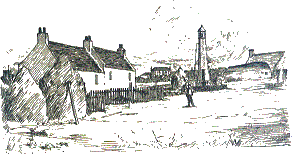
TORRY, 1870.
—But let us pray that our rulers remember that the
world is a temple as well as a market, and that in their efforts to
build up the new town and develop a great industry, the sweet retreats
by hill and shore be guarded with jealous care. With wisdom and
foresight the Girdleness plateau has been secured for the people, but
this is only a first step. The Greyhope road, with its magnificent
prospects of distant hill and neighbouring harbour, of city and sea,
must stretch out through the new Torry Park, down the braes to the Bay
of Nigg, and thence, skirting the Tullos Hill, join the south road to
Aberdeen. Then, with the old well restored, and Tullos Hill secured as
a "commonty," the ancient pilgimages, freed from the superstitions of
the past, may be resumed, and the blessing of the Saint will rest upon
the people.
When the sea winds blow, and finger
the boughs like the strings of a lute,
Then anger will sleep—lulled deep, by the song of a bird;
And hate will be chastened to love by the West Wind's flute;
And greed will be led by sweet Charity's hand that will guide him
and gird;
And the power of a peace upon the earth will charm the harsh tongues
mute,
When the sea winds blow.
The Rhymes of St.
Fittick.
SAINT FITTICK'S WELL :
A LAMENT AND APPEAL
FORSAKEN, sighing o'er her crumbling bank,
The withering sea-pinks spangled in her hair,
Her sorrows crooning to the sea-winds dank,
The Nymph of Downie sits in lone despair.
The wan moon lit at times the lifting bay,
And bridged with light the sea, from land to sky,
While from the verge the voices stilled by day,
Incessant wrangling-murmured fretfully.
Sails gleam and go as swings the lighthouse flash,
But flash or fade no hopes for her relume ;
The grinding waters o'er the boulders dash,
And gnaw the land and ruthless shout her doom.
Forsaken, sighing o'er her broken well,
She, unavailing, weeps the years of yore,
When in the hollow rang yon silent bell,
And stricken pilgrims gathered by the shore.
Tho' proud Damascus claimed a peerless flood,
The haughty leper was compelled to roam,
But Jordan's stream where awful Prophets stood,
Or waters rising in the still Siloam,
Were blessed with powers no mightier than the pool
That, tireless, trickles to the insatiate sea,
O Sea, O Death, she moans, impatient, cruel,
Like Dragon, hissing, coils to ravish me.
O, Sister Wells, that flow behind the hill,
Sweet Sisters, trickling safely in the town,
Thy rulers guard each old historic rill
And poets dip in thee the laurel crown.
To thee, old Spa, no threatening ocean creeps,
No sea-storms spatter thee with brackish spray,
Safe, though thy great protector, Jameson, sleeps,
And Anderson, thy hard, has passed away.
Thy wrangling singers, Callirhoe, are gone,
Save one whose swan song softly lingers still
Long years since " Flights of Fancy " laurels won,
The tuneful champion of our Old Firhill.
And Corbie, comes there from the Bay of Nigg,
The roar of breakers to thy cosy bield,
Thy neighbour's doom is mine-the Auld Bow Brig—
I also perish-is there none to shield ?
Oh, Ancient " Mannie," still dost thou preside
Above the truck and chaffer of the "Green,"
Have pity on thy sister, for the tide
Is at her lips, and she must perish e'en.
Dear Sister Wells, that flow behind the hill,
Help, or I perish—swallowed by the sea ;
The loathsome crab will squatter in my rill,
And limpets spawn upon the walls of me.
Build up my banks, pile boulder-buttress high,
Beat back the gnawing, grinding, greedy bay,
And I will heal, for in me virtues lie,
And I will cleanse thee lepers every day.
Do business burdens weight the jaded brain,
Does "shop" encompass like a prison wall,
Do dinsome streets distract thee with their pain,
Or dark intrigues and plots municipal?
Come where my well in limpid stillnes lies,
For here no passion rages, save the sea ;
Here cares are lifted up and passion dies,
Sung into slumber by a lullaby
Of Summer Seas that softly kiss my brink,
When thou hast walled me from the North Wind's sweep,
And rolling pebbles musically clink
Where murmuring shallows whisper to the deep.
Then will I heal the pilgrims as of yore,
My virtues linger—all unspent my balm ;
And tossing troubles, loitering by my shore,
Like seas subsiding, settles into calm.
Then build my banks, pile boulder-buttress high,
Beat back the gnawing, grinding, greedy bay,
That I may yield the powers that in me lie,
That I may heal my lepers every day.
DEUX.
AT ST. FITTICK'S.
WILLIAM CARNIE.
UNCEASINGLY the bright swift waves
Come rushing to the shore,
And echo to the lonely graves
Of those long gone before ;
I stand beside St. Fittick's Well,—
I linger on the beach,
And listen to the full-tide swell
And think what it may teach.
Unceasingly the Ocean speaks
Of friends and days gone by ;
And ever waning memory seeks
Relief in silent sigh ;
The toil, the trials of youth's fair day,
The fears, the joys of life,
Are mirrored in yon restless bay
Its power, calm, and strife.
Unceasingly the billows move
Heaven's purpose to perform ;
In each soft gale there's peace and love-
Courage in fiercest storm:
My lengthened day is well nigh spent,
Earth's proud ambitions o'er ;
Once more I stray with sweet Content
By old St. Fittick's shore.
SEASIDE MUSINGS.
W. CADENHEAD.
THE sky's o'ercast with thin grey clouds
Nor smiling sunbeam seen ;
Save o'er the sea's horizon shed
A belt of golden sheen,
Which cheers the distant billows
As they smiling roll to land,
And gilds the sails that stud their breasts,
By gentle breezes fann'd.
I see the plaided shepherd,
And hear his bLeating flock,
As on their wanderings they pick
The herbage from the rock ;
Up the ravines the billows roll
With awe-inspiring sigh,
And 'mid their crevices to perch
The sea-fowl screaming fly.
Yon cloud that rides above the wave,
And greets the evening's smile,
Seems, as the radiance on its falls,
Some lovely distant isle ;
And yonder is a rent in it
That seems a haven fair,
And longing looks yon distant barque
To cast its anchor there.
O ! who has not some sunny isle
Where he would wish at last,
When comes the evening of his days
His anchor their to cast,
Some haven, where life's troubled waves
Were calmed down to the play
Of gentle lappings on the beach
Of Nigg's sequestered bay?
And though the over-circling clouds
Were dimming down to-night,
With pleasant memories and hope
The horizon still was bright.
ST. FITTICK'S CHURCHYARD
DEATH and the final mould -- Death where was life
And all its means of action, strength and hope,
Men, women, age and youth, voices and eyes,
Thoughts, passions, loves, sorrows and merriments,
Aims shared-in, histories entwined -- but now
Names on a mossgrown tablet; underneath,
Death and the final mould.
Only the brave old belfry, faithful yet,
Stands sentinel by these poor vestiges,
And when the sun is high protects their place
With kindly shadow; or throughout the night
Takes from the busy wind a secret speech
And, in each cranny, whispers of the hands
That raised it long ago and cherished it;
While from the rock near by the dirging sea
Eternally condoles.
W. G. S.
THE SILLER MARRIAGE
BY WILLIAM ANDERSON
Author of "Jean Findlater's
Loon," etc.
[Married at Torry, on
Tuesday last, James Shepherd, barber and field preacher, aged twenty,
to Miss Nelly Auld, Nigg, aged seventy-seven, three feet high, and
deformed to the last degree of distortion. Though the day was very
stormy and rough, yet so great was the public curiosity, that not only
the ferry-boat but the whale-boats were employed the greater part of
the day in conveying people across the river to witness so very
extraordinary nuptials.—From Aberdeen Journal, 1797.]
IN a Country weel scatter'd wi' hillocks and cairns,
Where the chain o' the Grampians slopes to the sea—
An' the fowk are renowned as the men o' the Mearns—
Stan's the parish o' Nigg, near the mou' o' the Dee.
There lived an auld wifie o' seventy an' twa—
A couthie wee body, tho' stoopin' twa fauld—
Half a century sinsyne, as tradition can shaw,
Kent weel through the country as blythe Nelly Auld.
She joket wi' youngsters, an' played wi' the weans,
Though wrinkled an' yellow wi' age was her face.
For she was as wanton's a quean in her teens,
An' the wifie was come o' the white-fisher race.
She min't upon Cumberland troops gaen south,
Wi' their braw cocket hats, an' demeanour sae bauld,
An' liket to crack o' the scenes o' her youth,
Yet a maiden unmarried was gay Nelly Auld.
The toun's-fowk o' Mayday gaed crowdin' in flocks—
Lads an' lasses in hunners, 'twas just like a fair—
Seekin' fun o'er at Torry or dulse at the rocks,
Climbin' through at the Needle or Brig o' ae Hair.
They gather'd the badderlock, buckie, an' wilk,
Syne away o'er the rocks an' the hillocks they crawl'd.
For partans at Burnbanks, an' whisky an' milk,
Or a drap o' Geneva frae kin' Nelly Auld.
The feck o' our gentry frequentit her house,
For brawly they kent wi' the canty auld body,
Though Provost or Pauper they wad get a house,
As she had quite a talent at mixin' o' toddy.
A set o' droll chiels, on a fine afternoon,
Wad fuddle an' drink till they a' were keelhaul'd,
Nor yet dream, nor think, o' returnin' to toun,'
But sleep i' the barn o' clean Nelly Auld.
Smuggl't gin was in fashion, an', what wad ye think,
The auld gill was tippence, an' Alister Robb
A hale winter nicht on a sixpence could drink,
An' said he wad drink himself rich by the job.
Ae nicht that a core o' our nabobs were there,
They proposed i' their fun, as the story is tauld,
To Alister, tho' he was threescore an' mair,
A marriage between him' an' auld Nelly Auld.
Nelly giggi'd an' leuch like a lassie o' twenty—
Next week was agreed on to finish the rig ;
An' Alister blin'-fu' said he wis content aye,
Sae they bookit them baith in the Kirktown o' Nigg.
Siller marriages fifty years syne war in vogue ;
Ilka guest brought an offerin', with which they install'd
The pair-wha provided the meat an' the grog—
An' sic was the wedding o' wee Nelly Auld.
Croods cam' frae the country, an' croods frae the
toon ;
My mither heard lang Lizzie Wobster declare
That some gaed a shillin', an' ithers a croun,
An' countit owre four hunner couples an' mair.
An anker o' gin in a tub was made punch—
They drank helter-skelter to keep out the cauld ;
A hail rostit stirkie there was for a lunch,
To adorn the marriage o' braw Nelly Auld.
Clinchie Blake, wi' his fiddle, was in frae
Whitestripes—
Frae the lord to the beggar a' classes were seen;
Robbie Jack an' his son frae Dalmaick wi' their pipes—
Sic a weddin' in Mearnshire never had been.
A' distinction an' difference were lost at the feast—
Sic dancin' an' drinkin' had never been pall'd,
And they daff'd till the sun was far up in the east,
Then they beddet the bridegroom an' dear Nelly Auld.
But Nellie car'd little for blessin' or ban—
It was generally thocht that the body was rich—
An' happy, at last, she had gotten a man,
Her braw siller marriage had gaen her a hitch.
Be that as it may, it is plain to be seen,
Wi' horses, an' cattle, an' sheep in their fauld,
Her nephews are a' muckle fairmers at Skene,
An' may weel bless the marriage o' auld Nelly Auld.
THE DUEL.
BY ALEXANDER ROBB
Poems and Songs. 1852.
Torry has witnessed
many a deadly struggle, but the warlike encounter commemorated in the
following verses by Deacon Robb was happier in its termination than
most others. The event happened about 1812. A Count and a Baron,
well-known men in the Aberdeen of those days, quarrelled in a ballroom
in town. The Baron tweaked the Count's nose, when,
LIKE ony roarin' lion stout
The Baron swore aloud,
" For this insult upon my snout
O Count, I'll have your blood !
" Then name your arms and time to yok',
An' name the field of glory.
Pistols-the morn, at five o'clock,
Upon the hills o' Torry.
Now frae the east red rose the sun
Like ony copper kettle,
And o'er the Cove portentous shone
Upon the field of battle.
His beams had scarce begun to lick
The dew frae aff the heather,
When baith the lads, to time exact,
Were on the field together.
A doctor in the howe appeared
To wait the grand attack,
Wi' a' his instruments prepared
The bullets to extract.
The grun' was paced, and pistols, tee,
Waur loaded, prim'd, and cocket,
And seconds stood aside, to see
Wha first su'd kick the bucket.
The birds and beasts gaed daft for fear
As soon's they heard the pistols;
And fisher wives cried, Lord be here !
As they were gatherin' mussels.
The gu's and kittyweakes screamed
To hear the dire commotion ;
An' skate an' haddocks quicker swimm'd
Out through the German Ocean.
As fly the waves against a rock,
So flew the balls o' lead ;
As meets a rock the dashing waves,
So firm the heroes steed.
Shot after shot came aff like stoure
Frae these redoubted champions,
An' crack for crack for half-an-hour
Resounded through the Grampians.
At length the Baron cried, " Hallo !
I'm curst if I can wound ye."
" I'm sorry I'm the same with you,"
Replied the Count, "confound ye."
" Then," says the Baron, " gie's your ban',
I'll ne'er say Count in future ;
" The Count said, " That's a gentleman,
I'm wae I twin'd your coutar. "
THE WRECK OF THE "OSCAR."
BY WILLIAM CADENHEAD.
IT was Nigg's lonely churchyard, beside the
murmuring ocean,
The roofless church was old and grey, for since its ancient walls
In years gone past resounded with the fervours of devotion,
They long had bleached in summer suns, or dripped in winter squalls.
Among the graves a sailor sat, his locks were long
and hoary,
All weather-beaten was his cheek by many a salt sea-breeze,
No doubt of calms and tempests wild he well could tell the story,
'Mid doldrums at the sultry Line, or blasts on Arctic Seas.
I asked the ancient mariner about his meditation
Among the mouldering monuments, among the grassy graves
Of that lone seaside churchyard, and this was his narration
Of strange and fortunate escapes from out the seething waves—
" It was the good ship ' Oscar,' bound for the
Arctic Ocean,
Upon the first of April, in the year of grace thirteen,
And loving hearts were thrilled that day by many a wild emotion,
For a whole whaling fleet had sailed from the Port of Aberdeen.
" I was on board the ' Oscar,' a young and ardent
dreamer,
Between her masts a garland hung with ribbons fluttering free,
For every sailor's sweetheart contributed a streamer
For luck to the good ' Oscar ' upon the frozen sea.
" The hawser was loosed cheerily that moored her to
the jetty,
The sails were set and off we sped beside the long stone pier,
The good ship, everyone declared, looked trim and taut and pretty
As she curtsied o'er the heaving bar amid a ringing cheer.
" Sometimes we tacked about the bay with very little
offing,
To wait a boat that was to bring some laggards of the crew,
For, heedless of the danger, some men will still keep loafing,
And this delay brought wild dismay, as soon they sadly knew.
" The day was, like most April days, made up of
shine and glooming
At times upon the heaving seas the sunlight glittered clear,
But all the while to eastward some heavy clouds were looming,
Which boded in the seamen's eyes some dirty weather near.
" It lulled, and on a heavy swell we drifted to the
leeward,
The vessel had no steering way ; the tide set in with stress ;
There was no wind to fill the sails to tack her to the seaward ;—
Let go the anchors !—or she strikes upon the Girdleness !
" Then from the east a hurricane sprang up with
furious rattle,
Driving the showers of blinding snow in fearful gusts and shocks ;
And the great breakers ran like steeds urged on to maddening battle;
The anchor drags-she's driving fast upon the fatal rocks !
" Cut down the main-mast ! it may bridge the fierce
and angry chasm
The carpenters and coopers all their saws and axes plied,
It did not fall athwart-ships ! and each heart was smote with spasm,
For it huddled down a useless log along the vessel's side.
" Then 'mid the din of breakers, and the great
chain-cable's clanking,
You heard the skipper's husky cry above the roaring squall,
Above the cracking timbers, and the crunching of the planking,
'Twas every man now for himself, and God be for us all !
" Of a brave crew of fourty-four that mann'd that
gallant whaler,
But only two, my mate and I, came living through the surf :—
That fatal Greyhope Bay has been the grave of many a sailor,
Whose loved ones cannot shed their tears uoon their grassy turf !
" 'Twas a sad scene this lone churchyard beside the
moaning billows
After the storm, the cast-ashores among the graves were laid,
Their sailor garbs their winding sheets, the wet green graves their
pillows,
That lovers and relations might claim their hapless dead.
" There was the skipper, brave and bluff, no more
his anchor dragging ;
The harpooner, shot down by shaft more subtle still than his;
The lover in his sweetheart's arms no more departure lagging;
The husband where the widow stands in speechless helplessness.
" Since then I've sailed in many a clime, by
continents and islands,
By icy bergs, or where the airs are balm and spicery,
Amid the roaring hurricane, or the calm's awful silence,
But now I've coiled my lanyards up- I go no more to sea.
" But oft I take a tack about, a thankful grey old
sailor,
And often sit a lonely hour among these grassy graves,
Musing upon the gallant crew of the ' Oscar,' luckless whaler,
And how my mate and I escaped from out the seething waves."
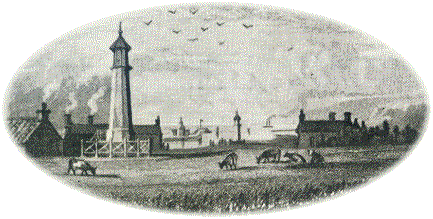
TORRY IN 1860.
St. Fittick's Church,
Torry.
AN APPEAL.
SO far back as September, 1894, the religious needs
of Torry, as a growing district, had been under the consideration of
the Kirk Session of Nigg, but it was not until early in the year 1896
that the Kirk Session resolved to proceed in the matter, and a public
meeting of the inhabitants of Torry was called for the18th of March in
that year.
At that meeting a Local Committee was appointed to
collect Subscriptions, and to act along with the Church Extension
Association of Aberdeen in taking the necessary steps for the erection
of a place of worship.
On 19th November, 1898. the foundation-stone of the
new Church was laid by Lauchlan M'Kinnon, Jun., Esq., Convener of the
Church Extension Committee, and on 24th November, 1899, St. Fittick's
Church was dedicated to the public worship of God.
Steps were then taken towards securing a minister
for the Church, and on 11th April, 1900, the Rev. Archibald Macintyre,
M.A., Assistant in the High Parish Church, Paisley, was elected to the
charge, and was ordained by the Presbytery of Aberdeen on the 17th of
July following.
Torry district has a population of 10,000, almost
entirely working class, with a large proportion of fishermen and fish
workers, who have migrated thither from villages all up and down the
East Coast, impelled by that stern necessity which no sentiment can
overcome; and to supply the religious needs of this large population
St. Fittick's Church was built, and its minister called.
The cost of the present unfinished building was
£2,313, towards which the Church Extension Committee of Aberdeen
raised the sum of £231, the Local Committee raised £220, the Baird
Trust gave £500, and the Home Mission Committee of the Church of
Scotland gave £259, leaving the sum of £1,000 yet unpaid.
The Congregation is of itself quite unable to face
the liquidation of so large a debt, hence our appeal to all who are
interested in Home Mission Work, and to all who would help to prevent
further lapsing from church ordinances by providing adequate
accommodation and service for a growing population.
The need is urgent, for the Church, as it stands,
contains only 550 sittings, nearly all of which are occupied, while
the growth of the congregation gives indication that soon the church
will have to be extended to the complete plan, giving accommodation to
818 worshippers, which will involve a further expenditure of £1,000
-an additional burden, which will mean strangulation unless the help
of friends enables the congregation to pay off the debt that at
present hangs on them.
It is proposed to hold a Bazaar in the Music Hall,
Aberdeen, on Thursday, Friday, and Saturday, 19th, 20th, and 21st
December, 1901, in preparation for which a Women's Work Party has been
meeting weekly for the past nine months, while at a Congregational
Meeting, held on the 1st of May last, a committee of over 50 male
members and friends was appointed to make the necessary arrangements.
The Presbytery of Aberdeen, at its meeting on 7th
May, cordially commended this Appeal to the liberality of all within
its bounds; and we can assure you of the gratitude of the Congregation
for any help you can afford us in our present efforts.
ARCHD. MACINTYRE,
Minister of St. Fittick's.
JAMES COUTTS,
Trustee, Vice-Chairman.
D. M. WALKER,
Clerk.
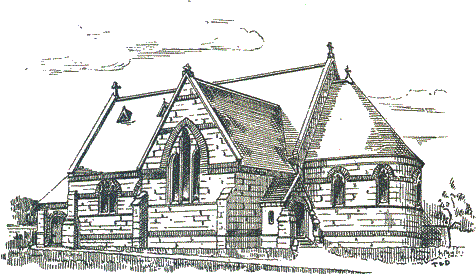
ST. FITTICK'S CHURCH.
|

